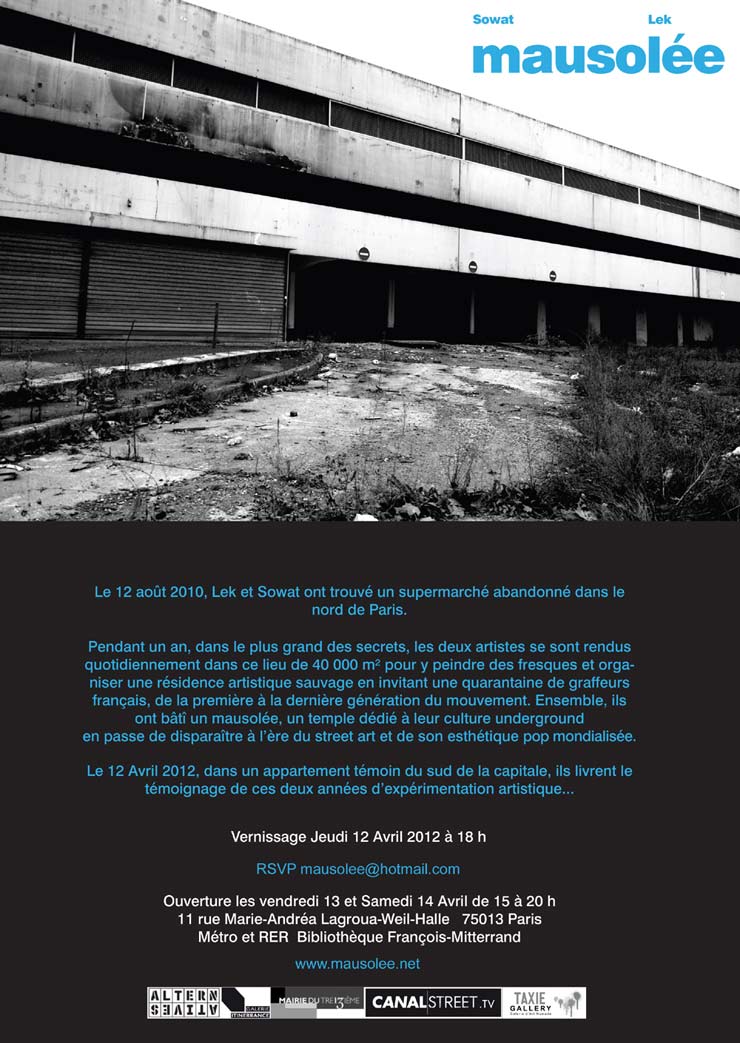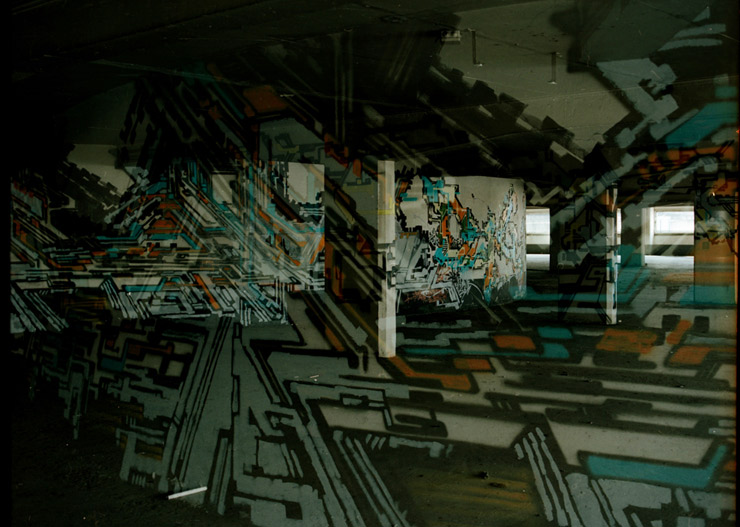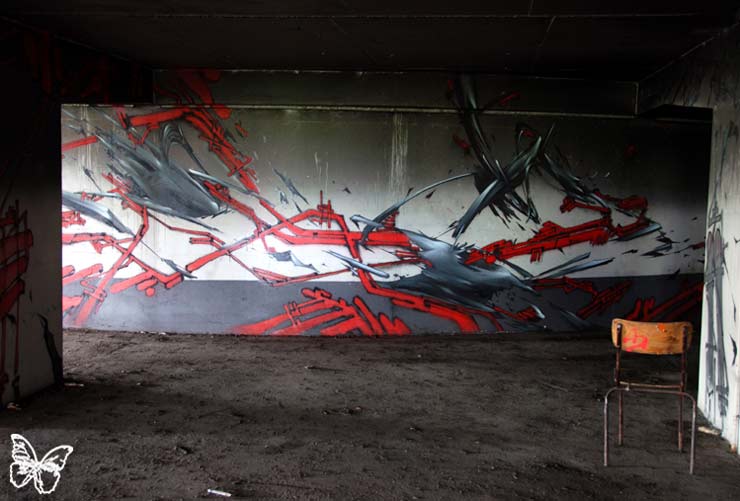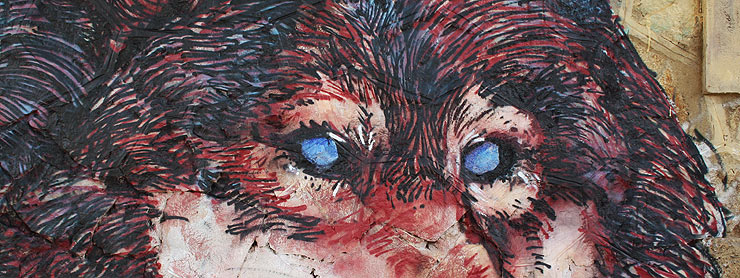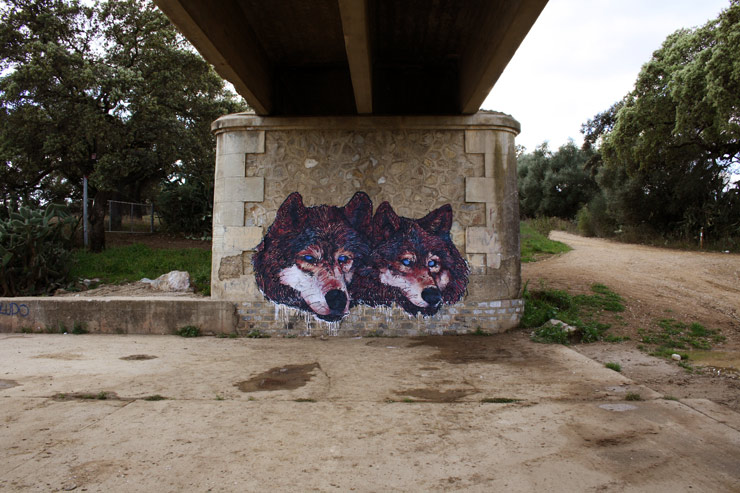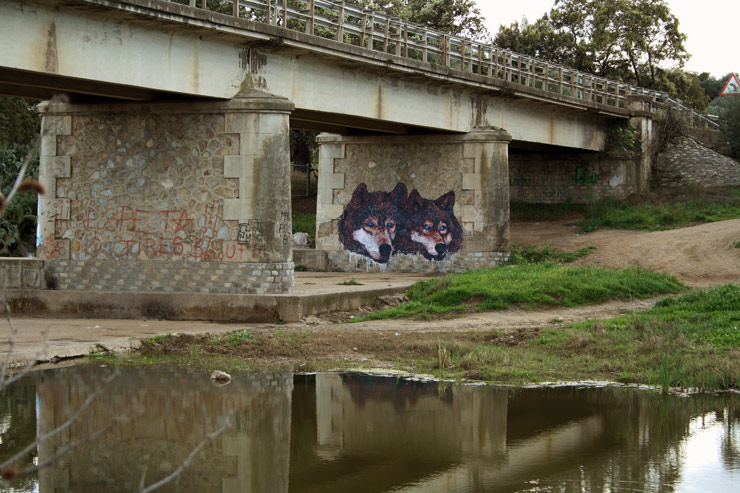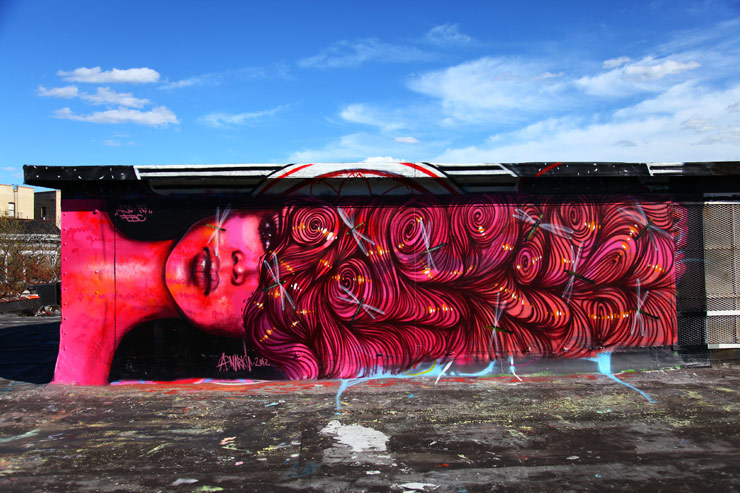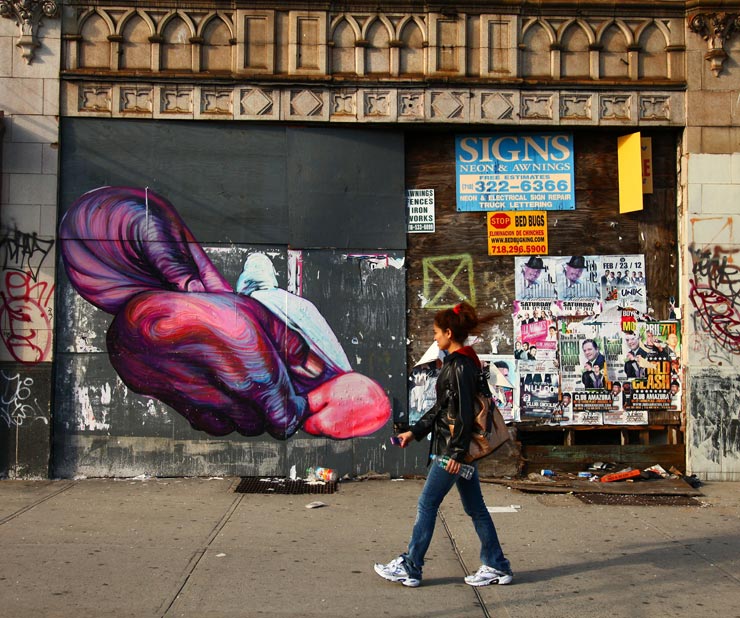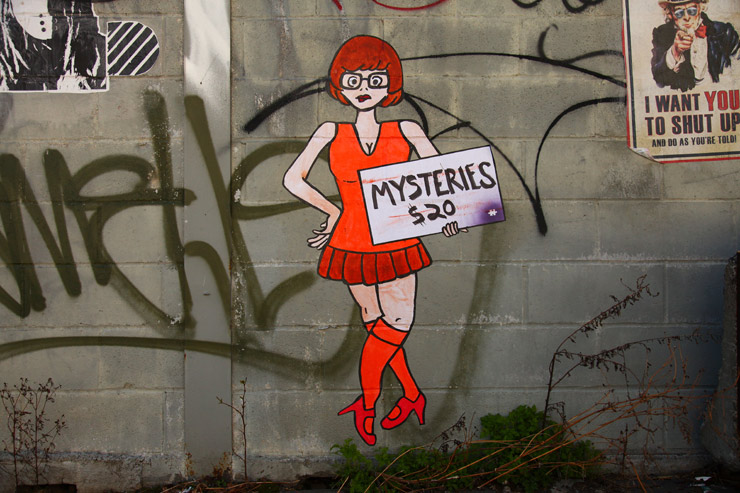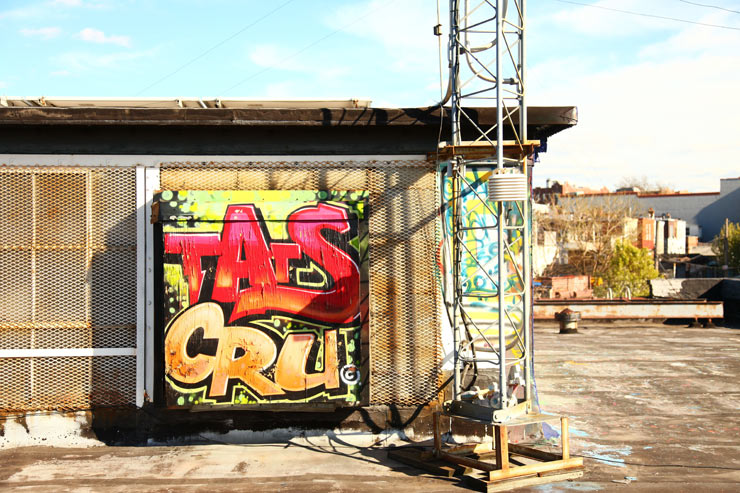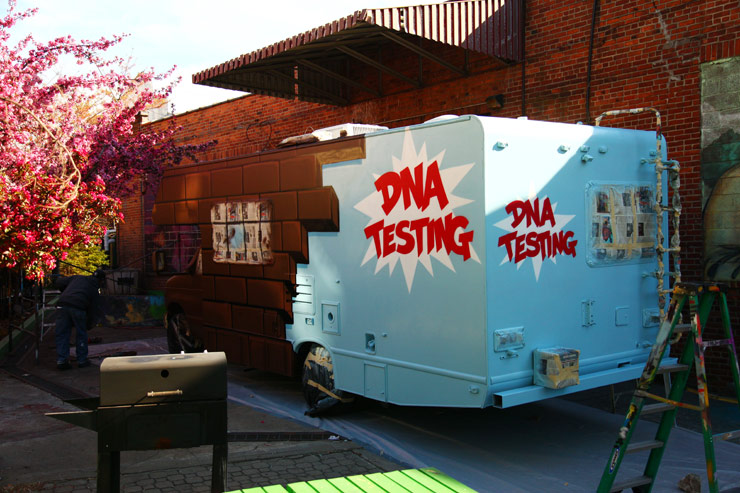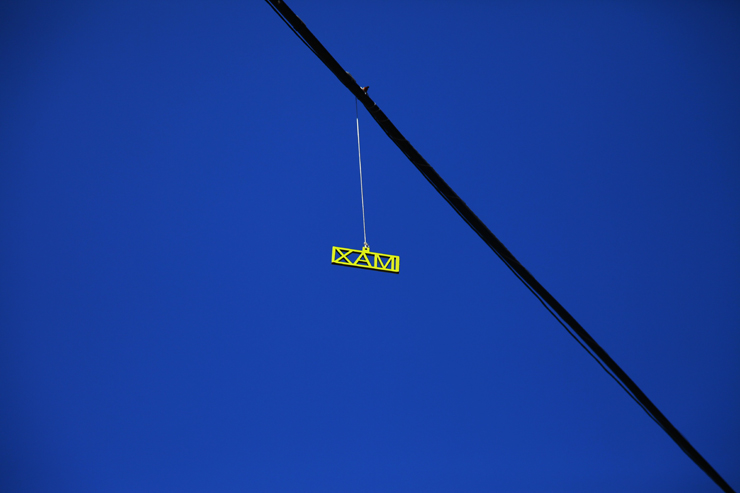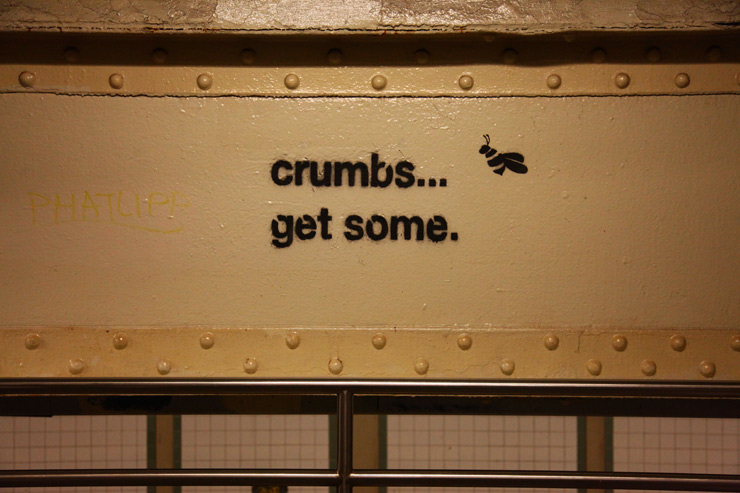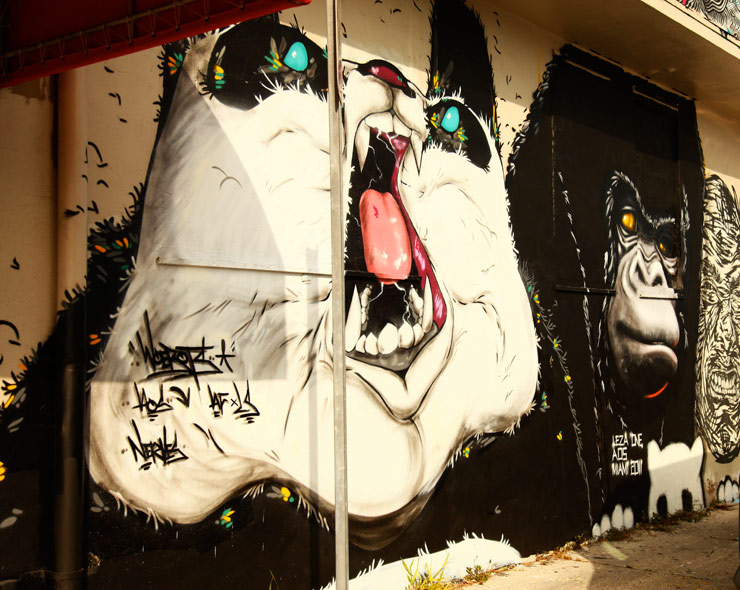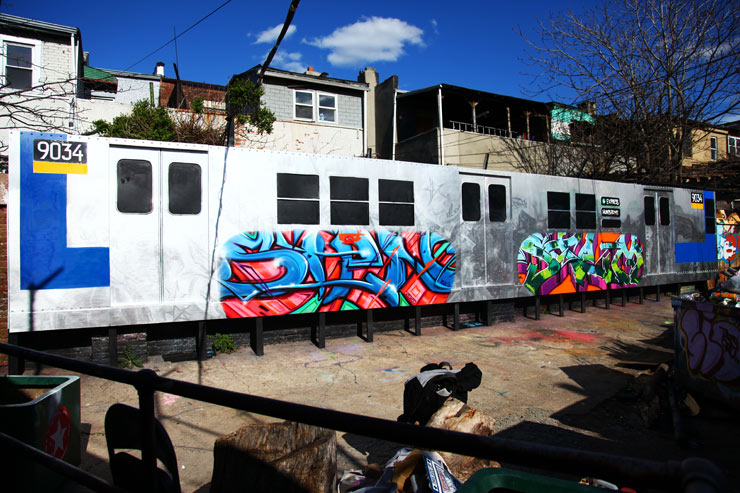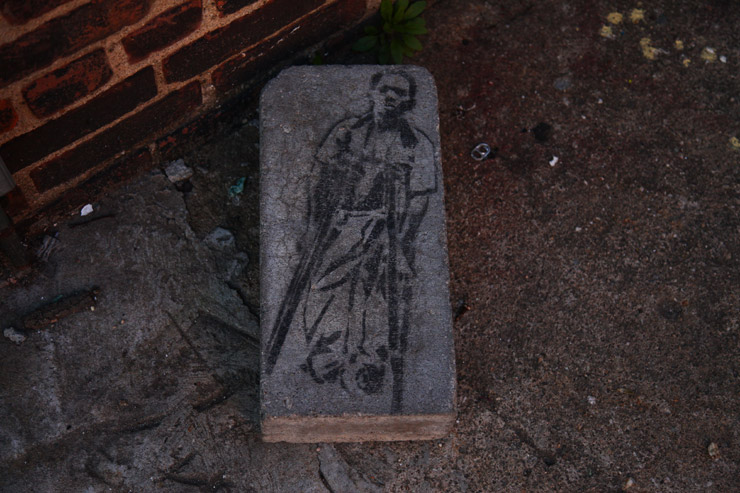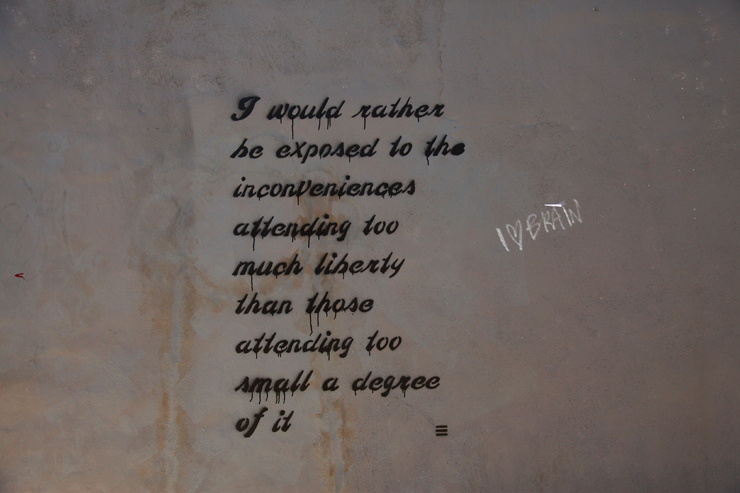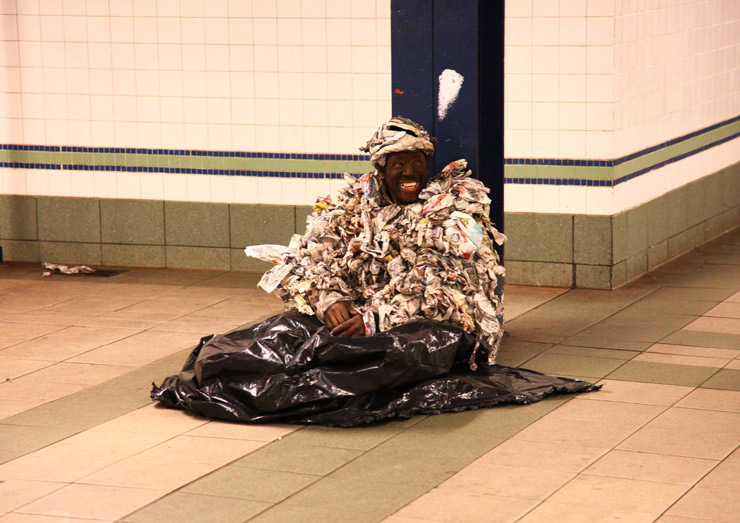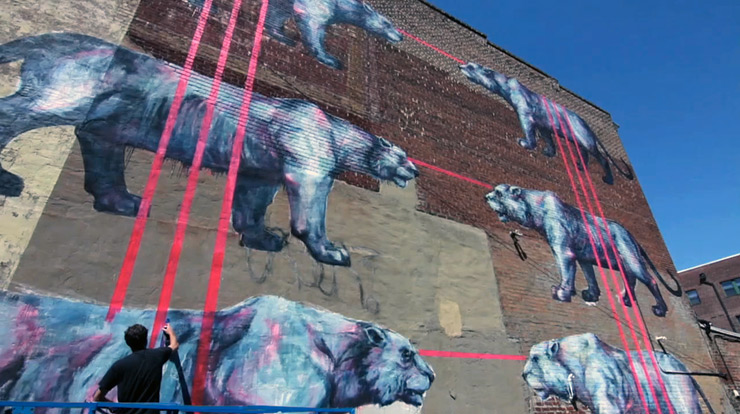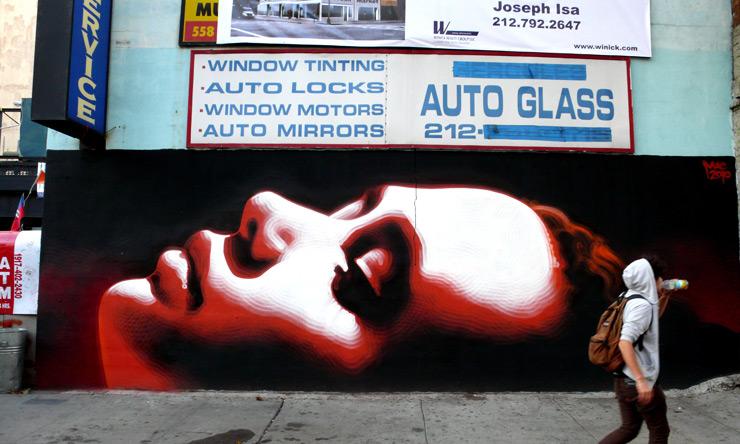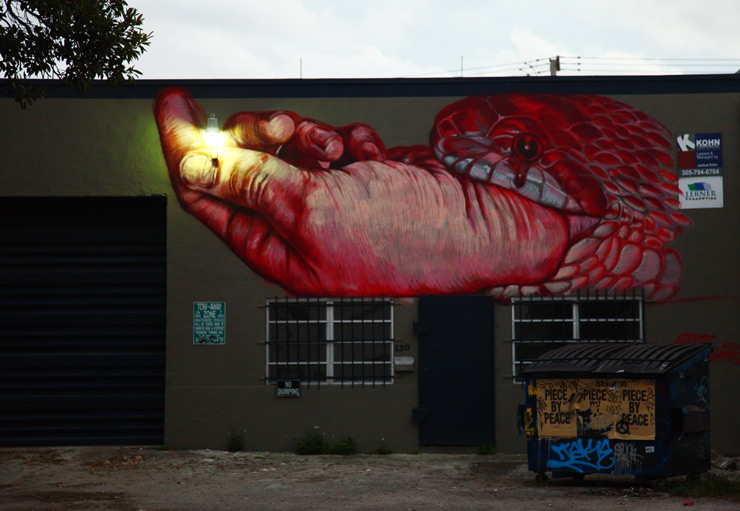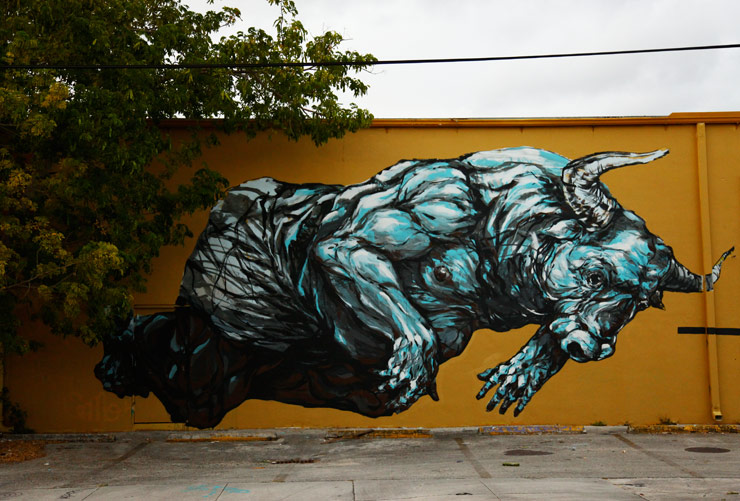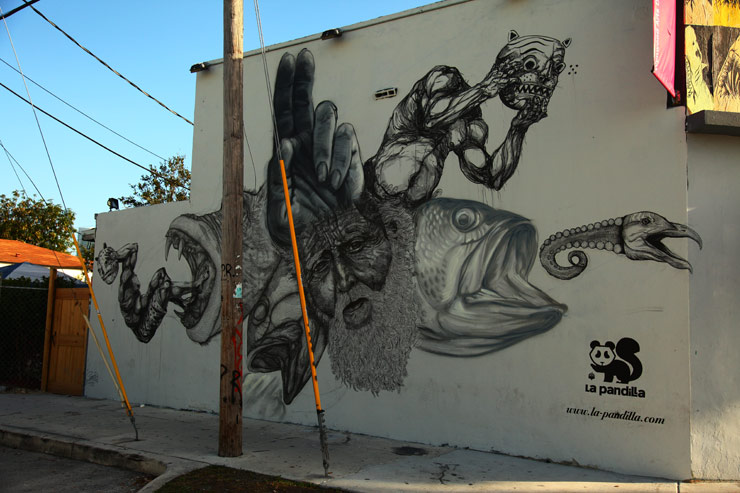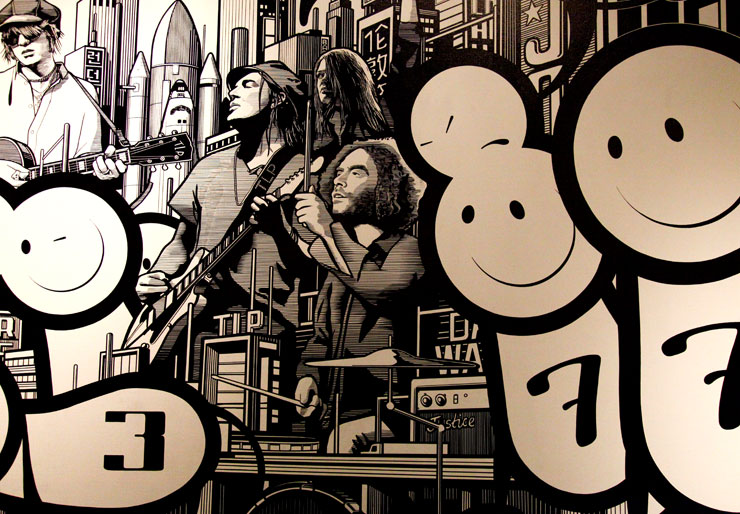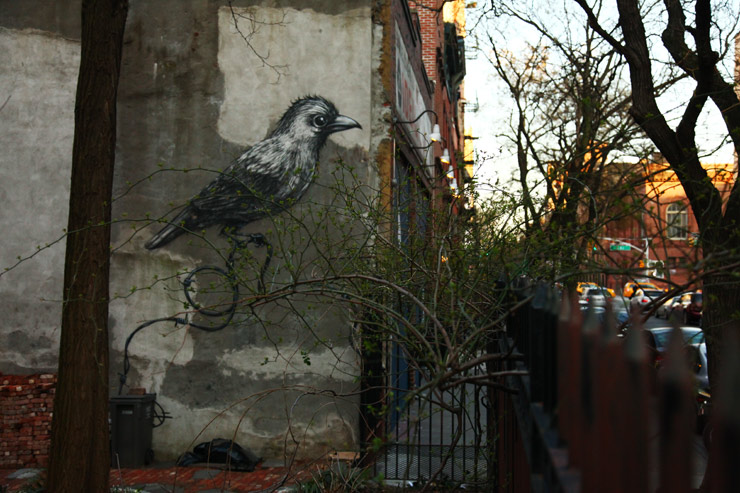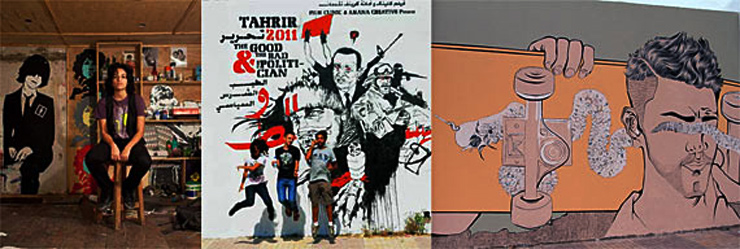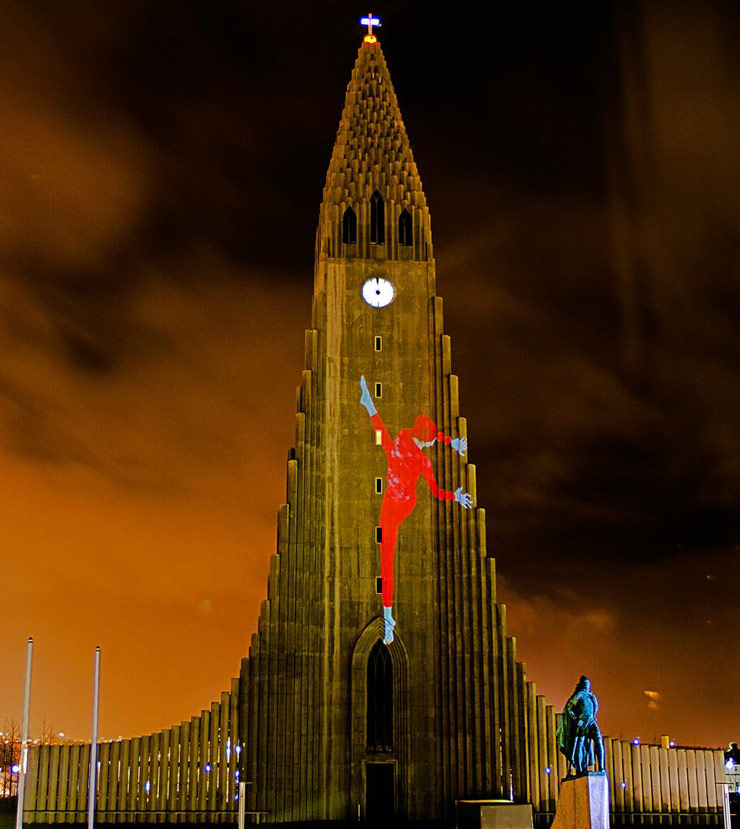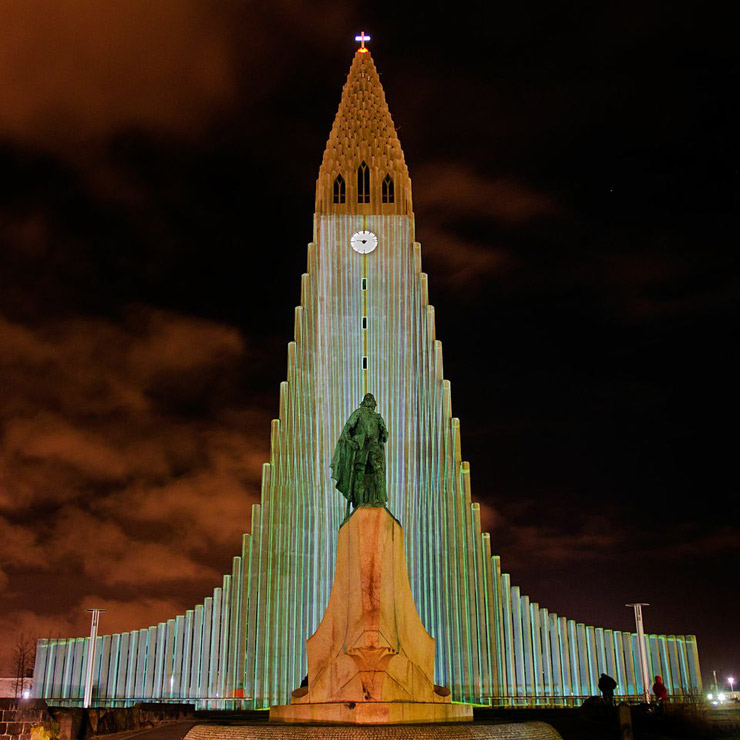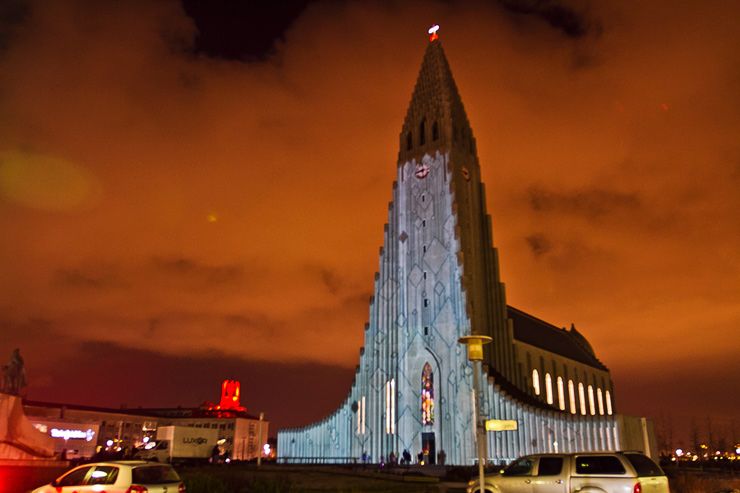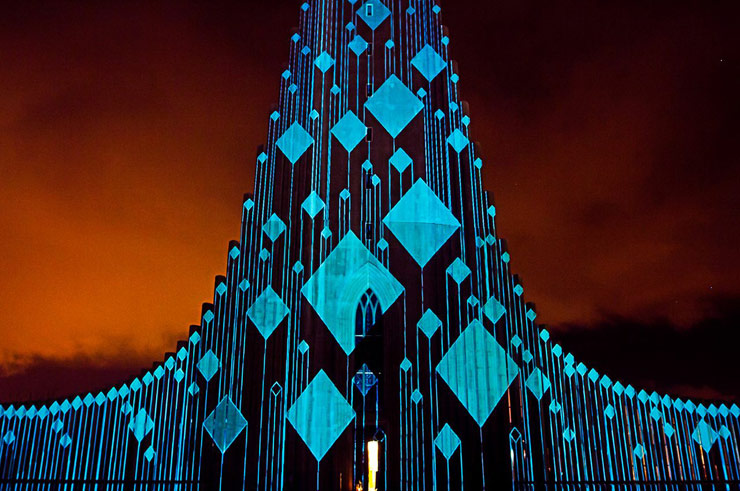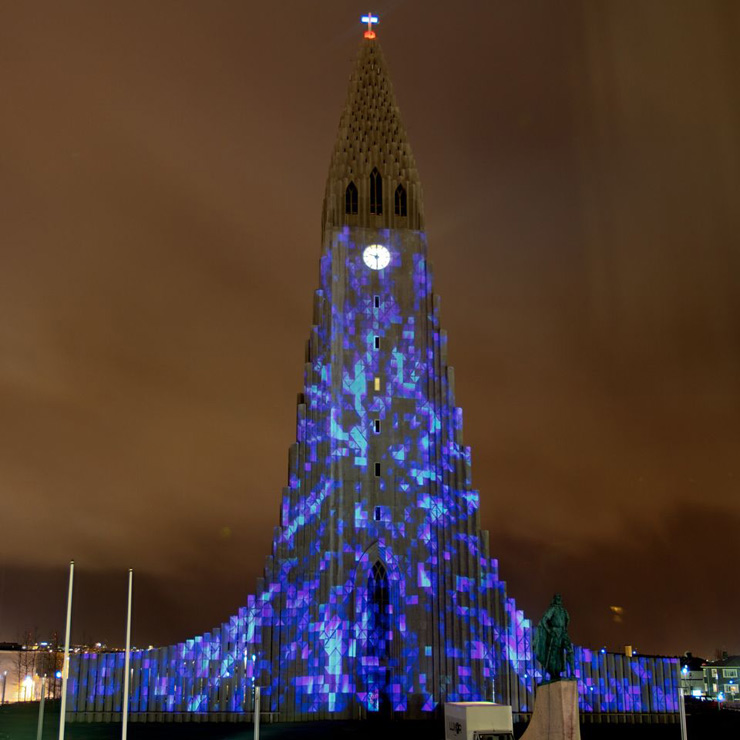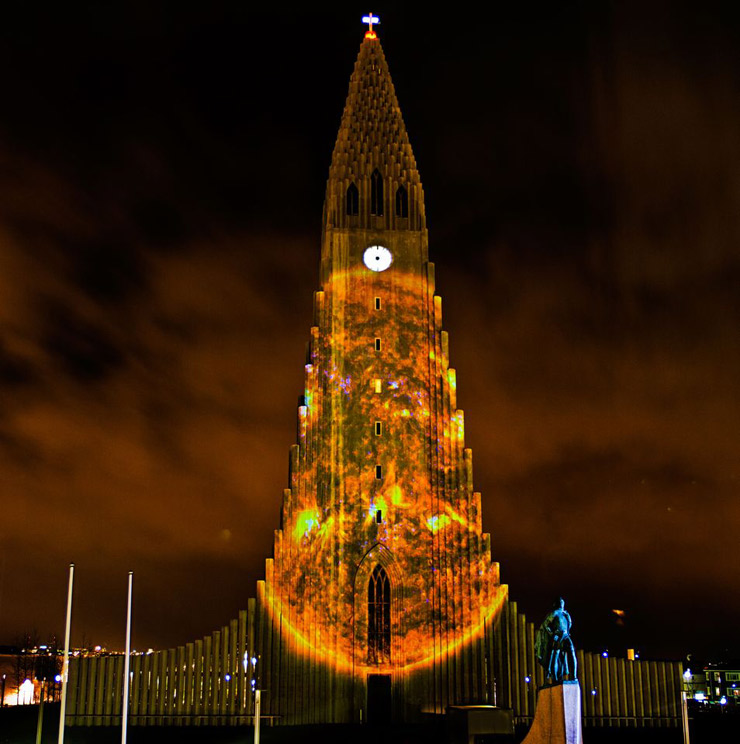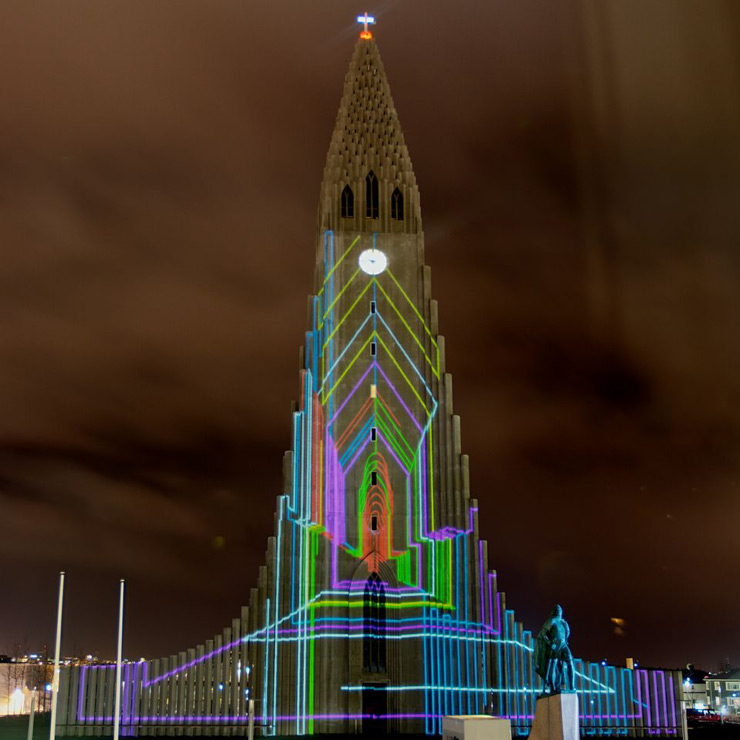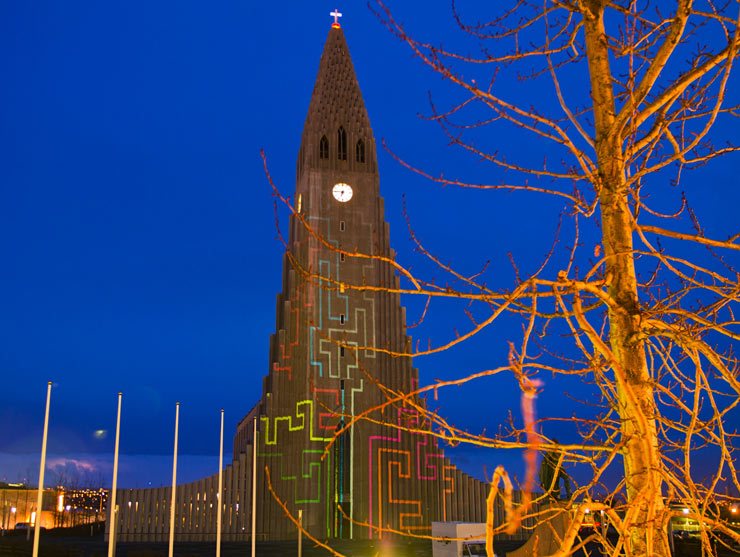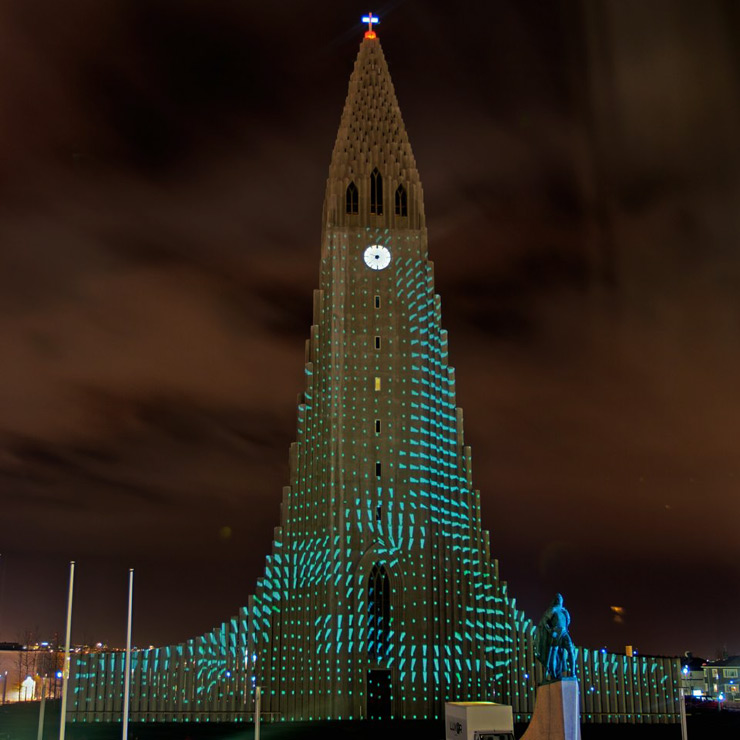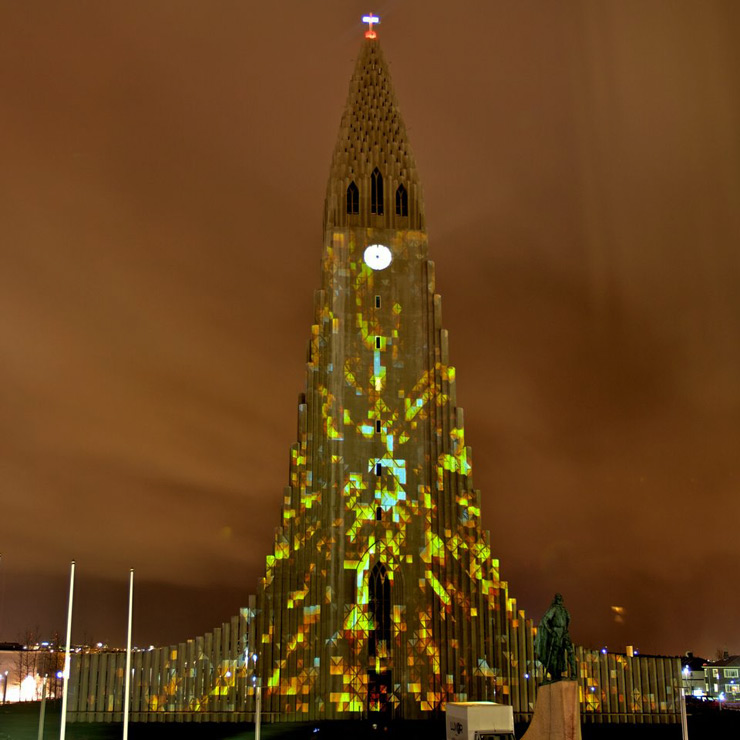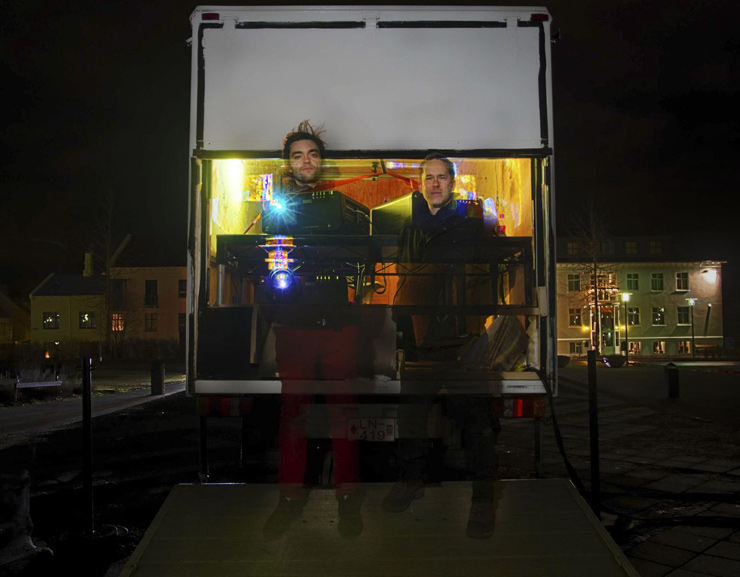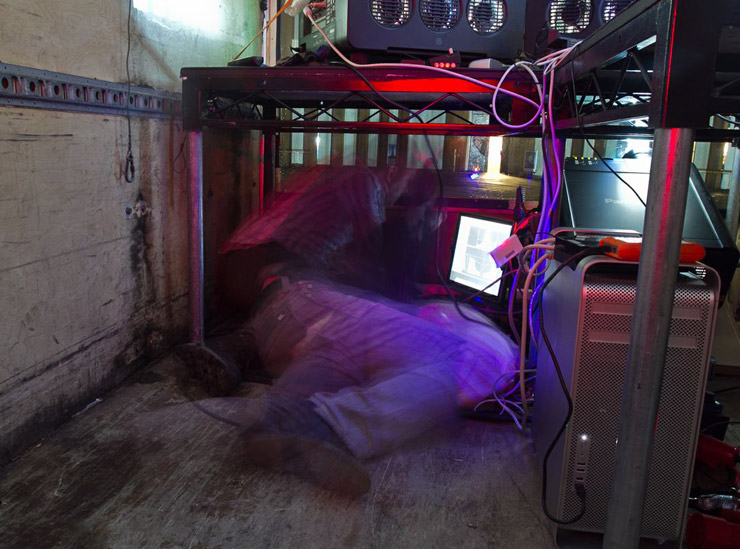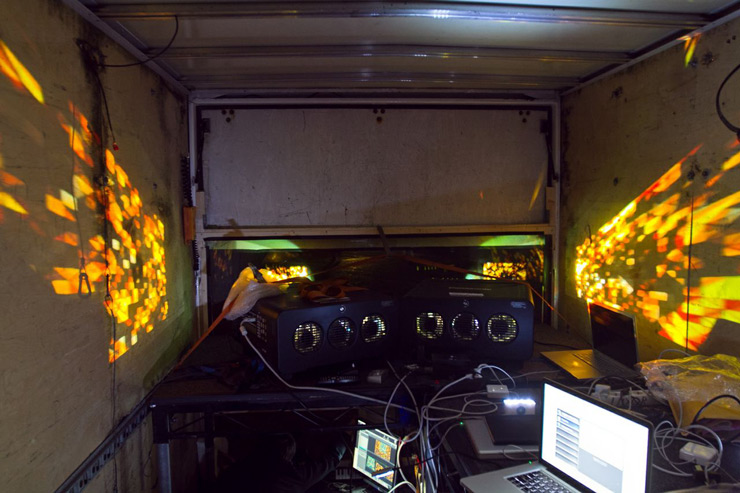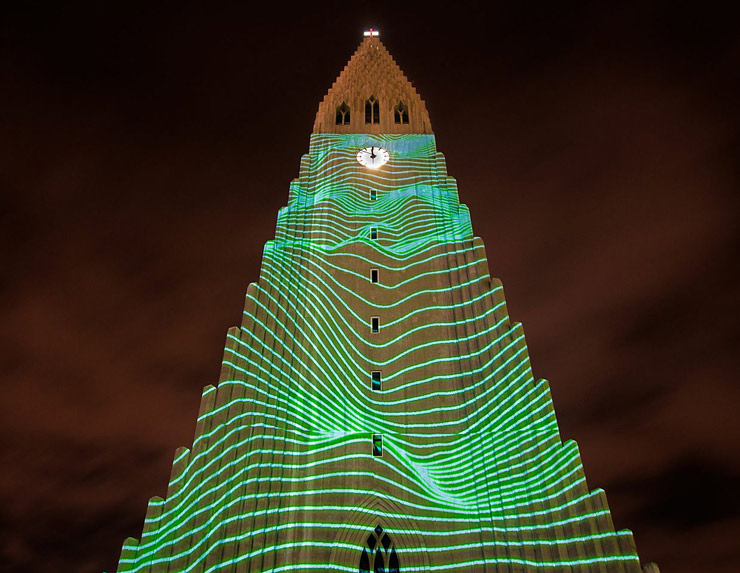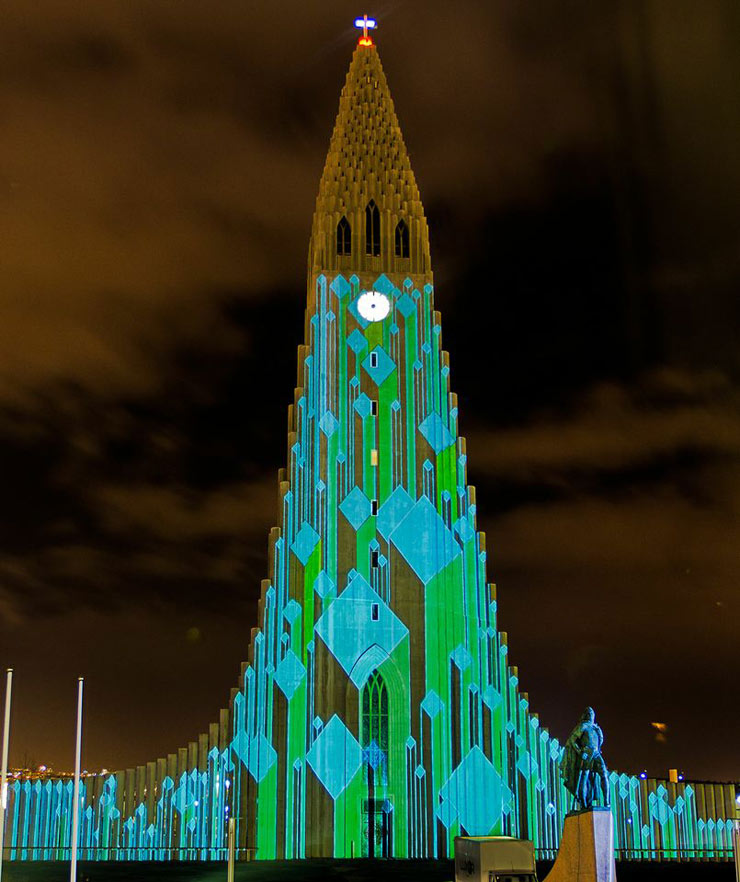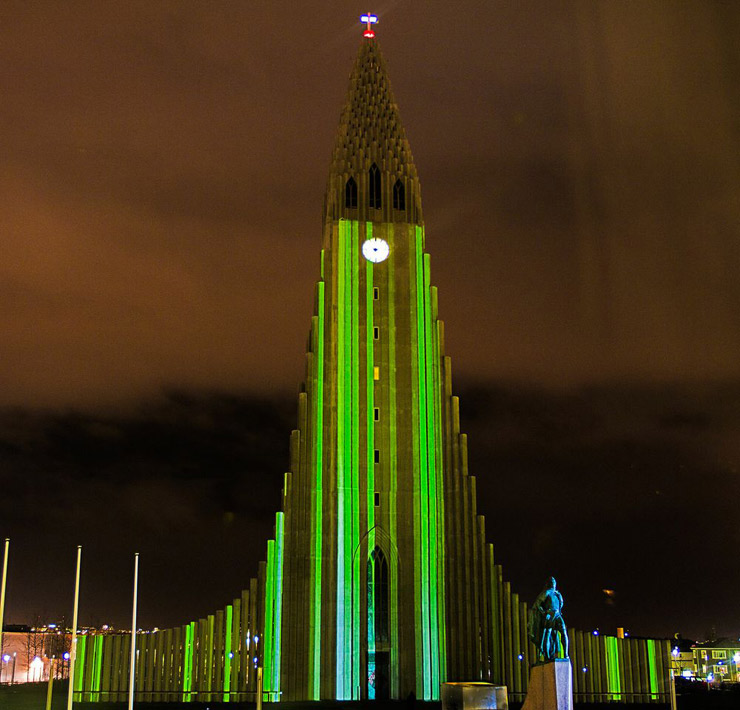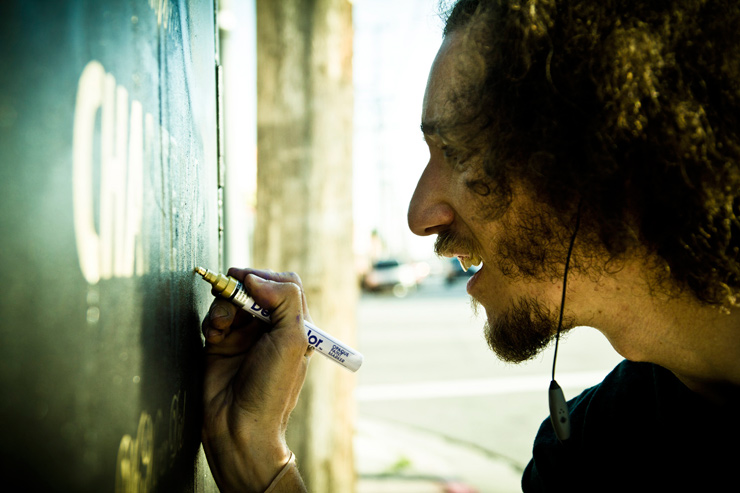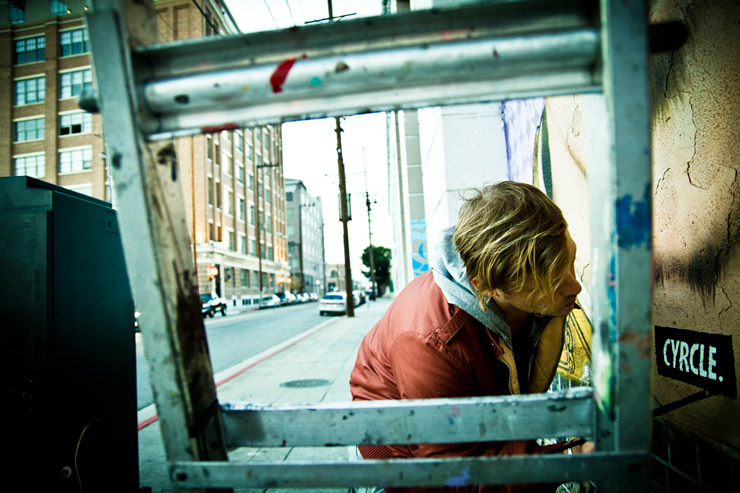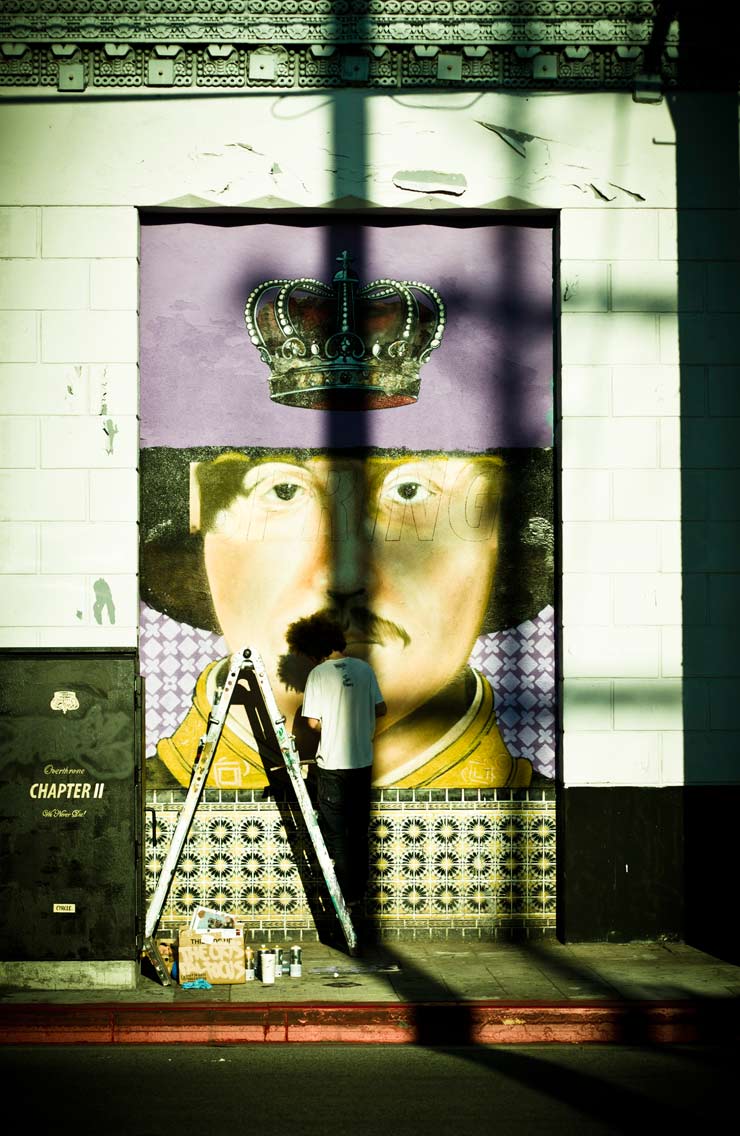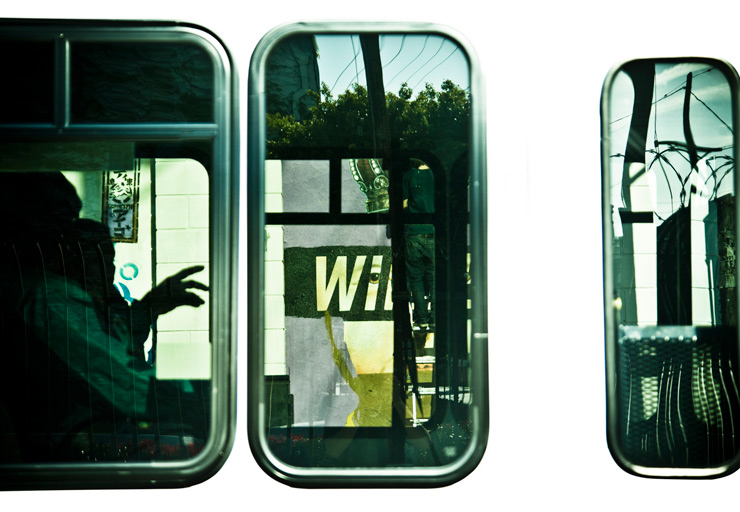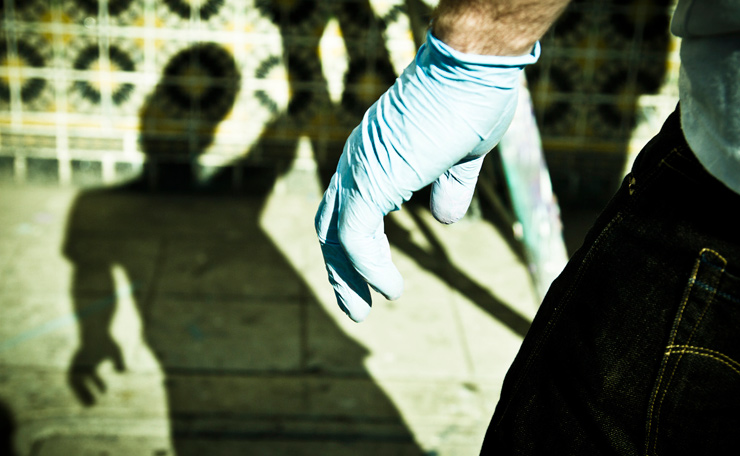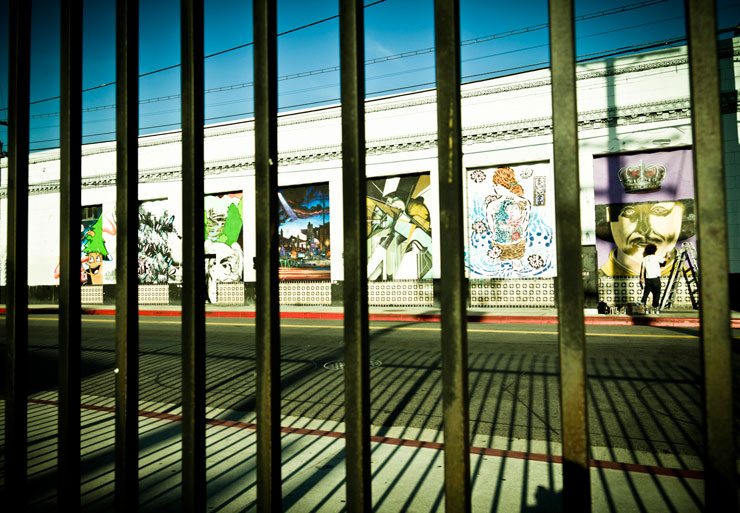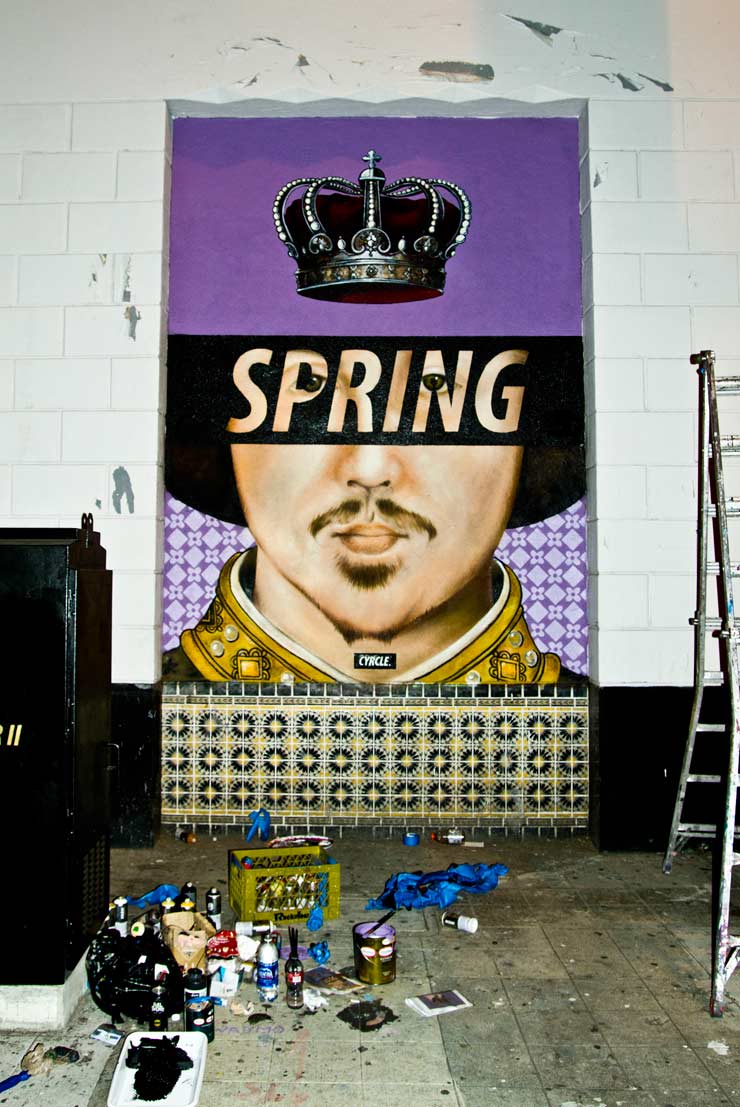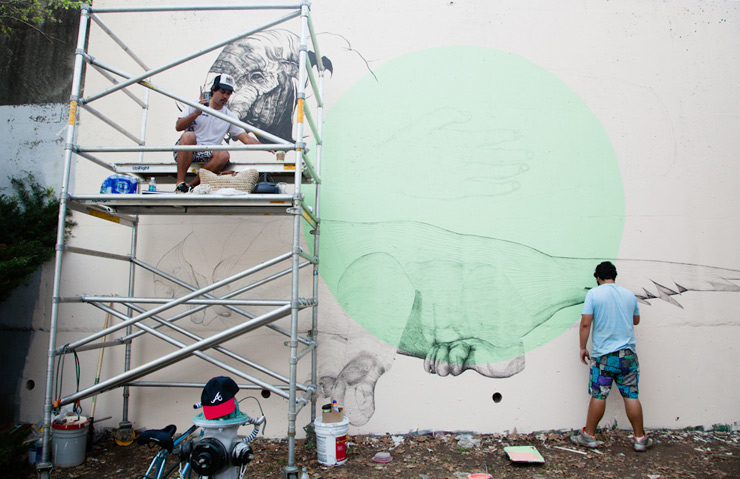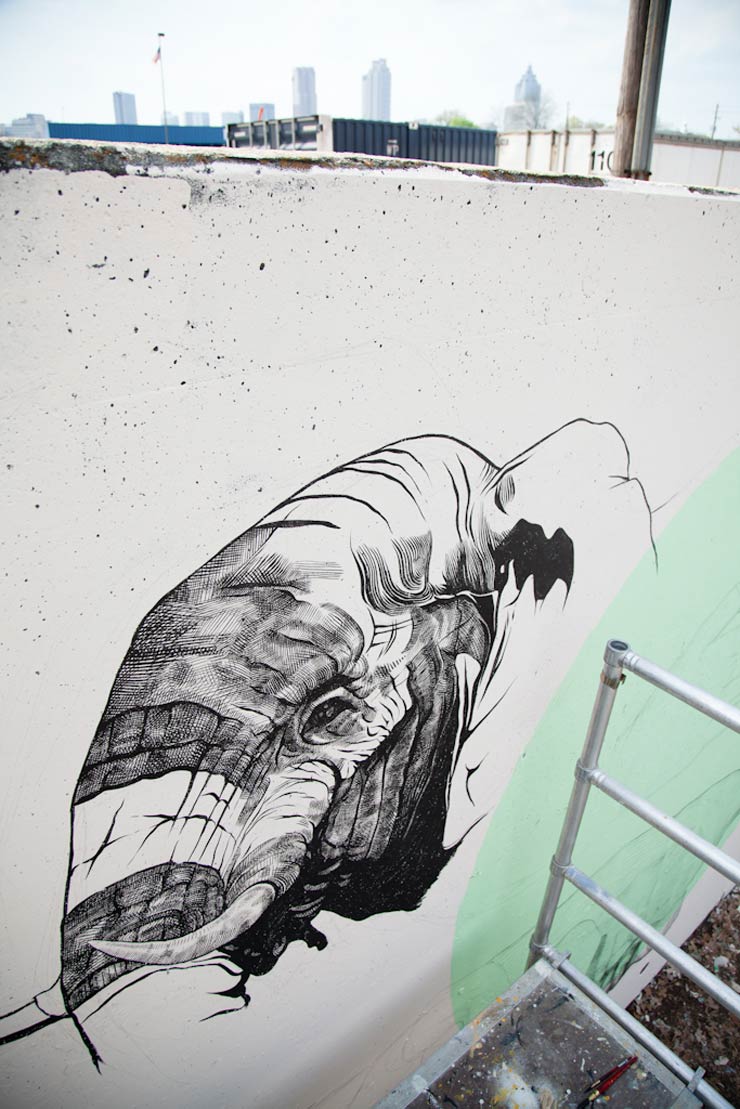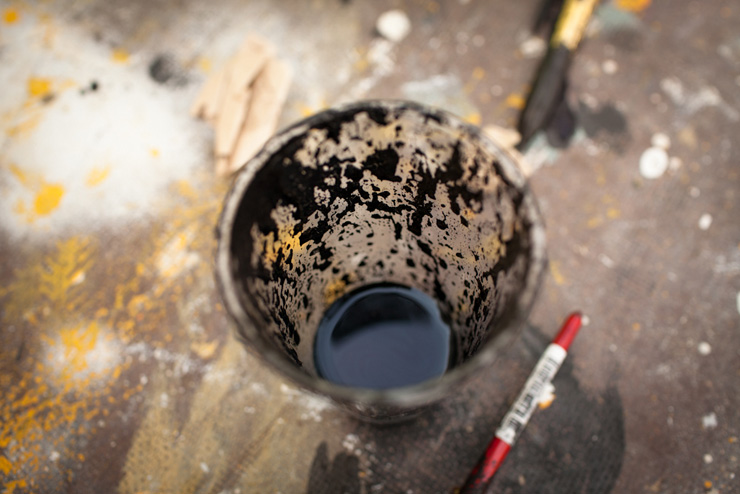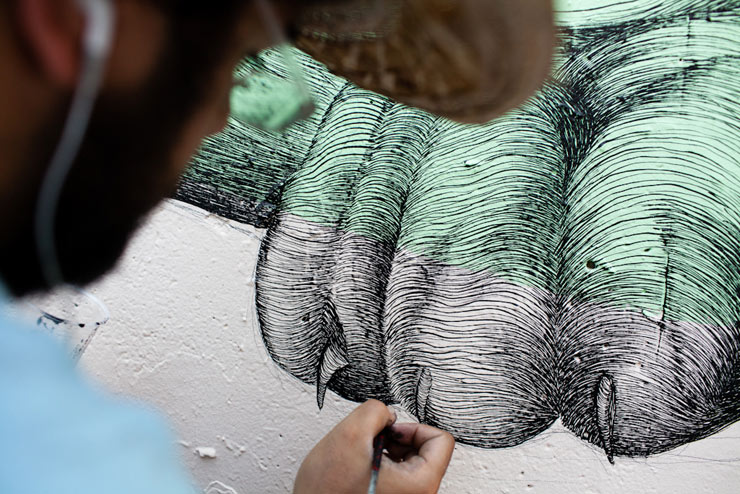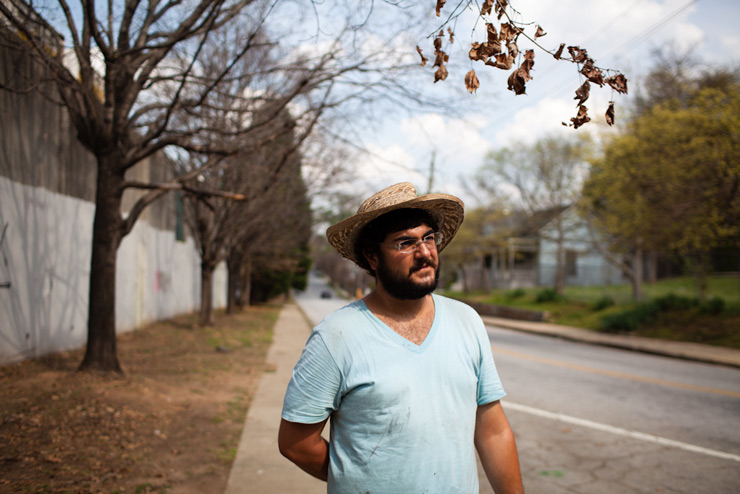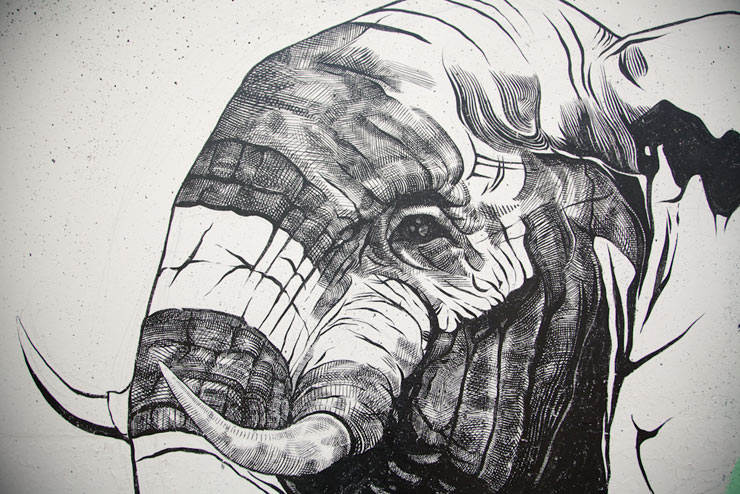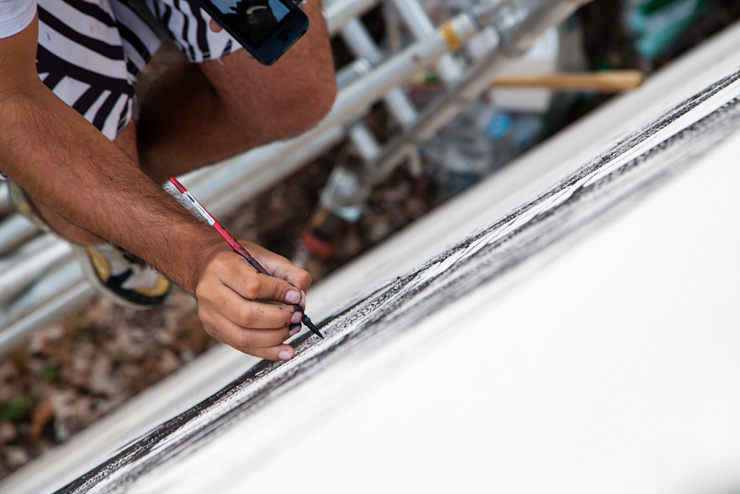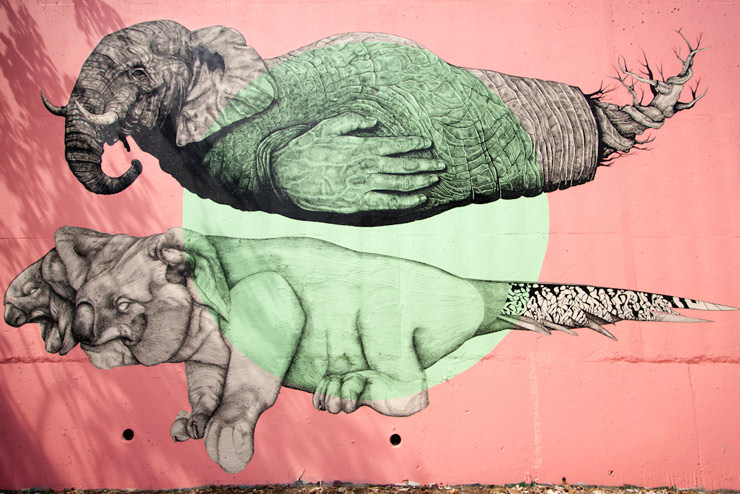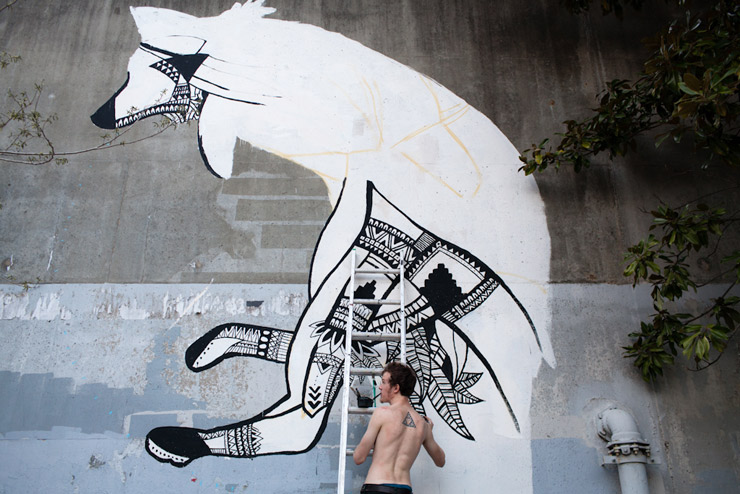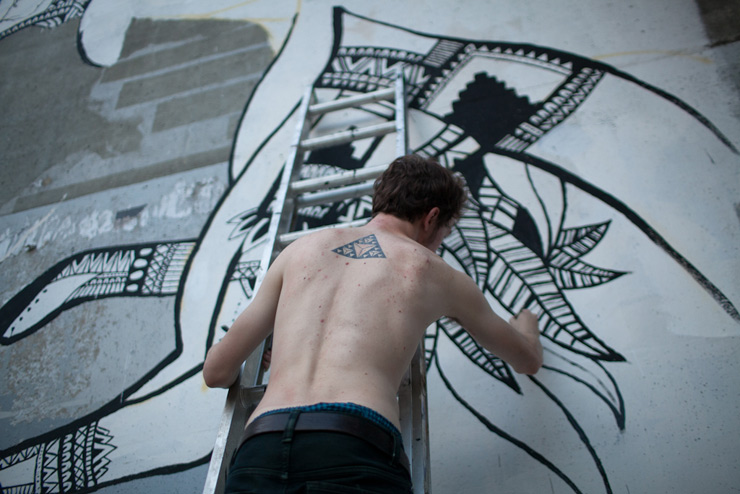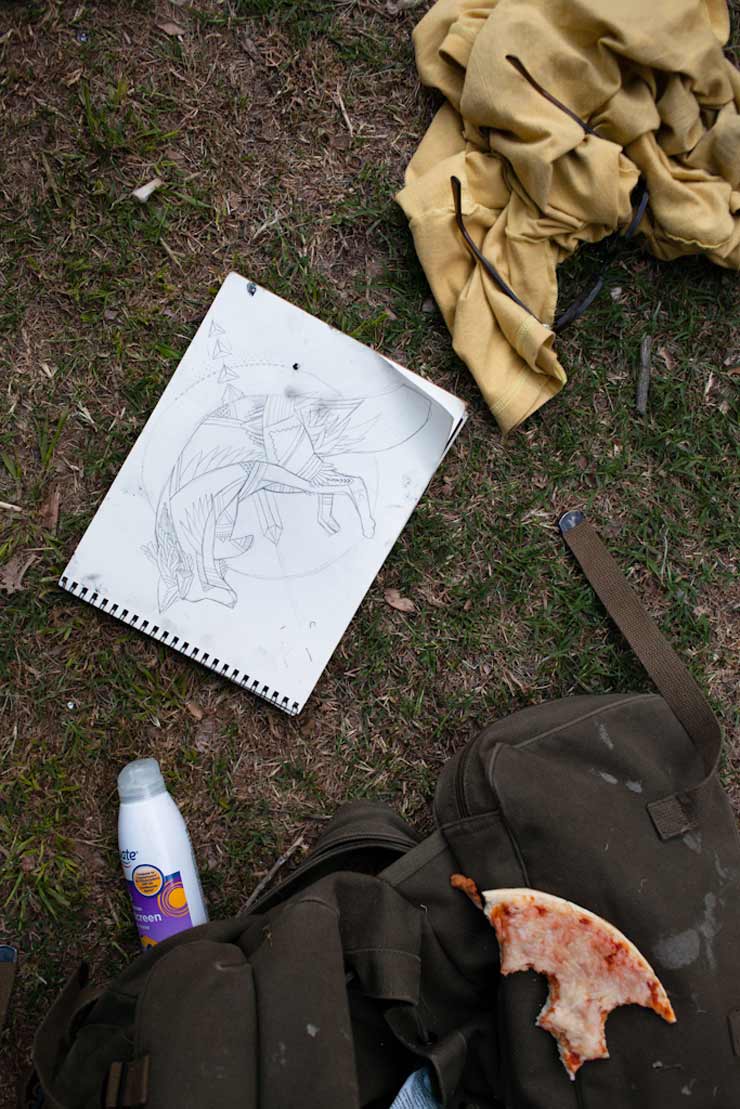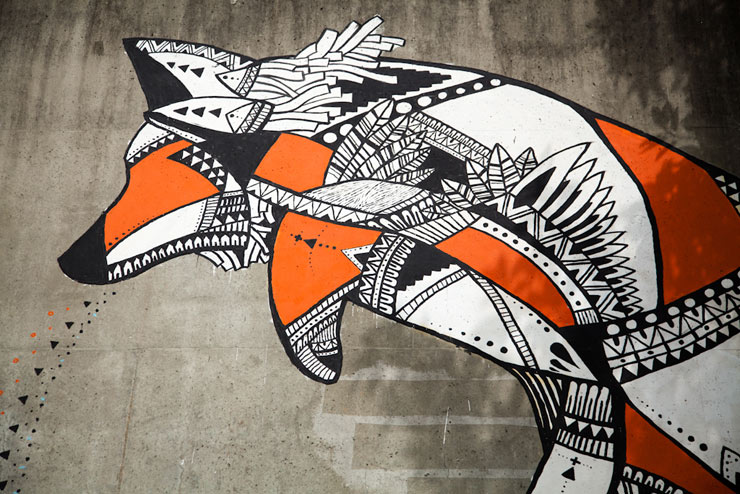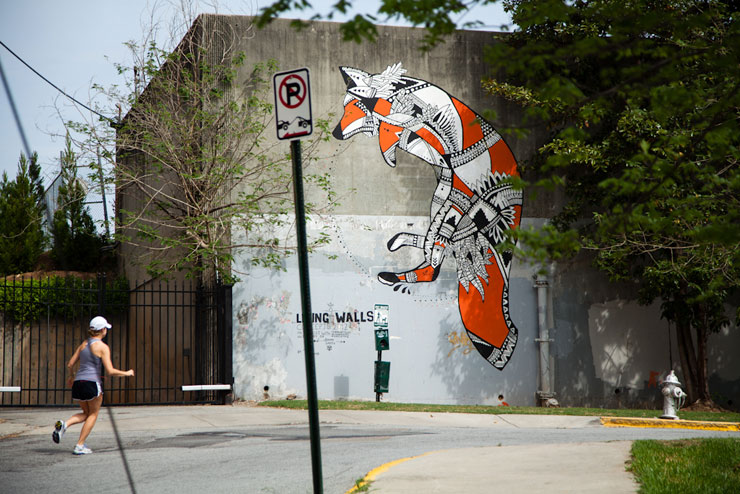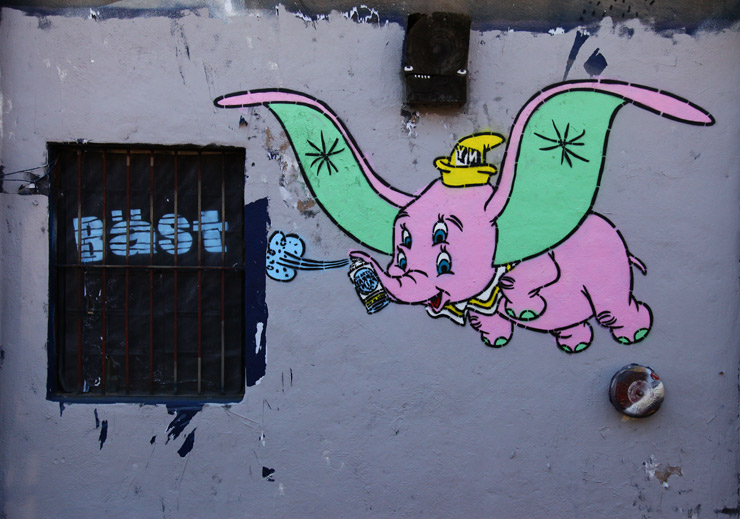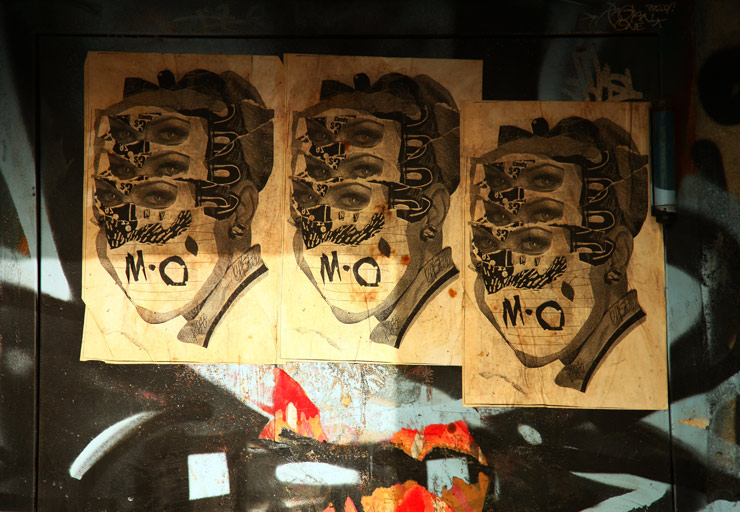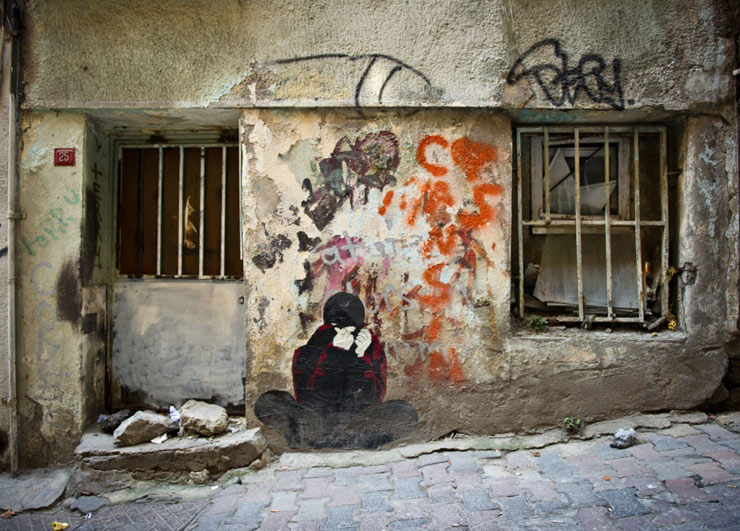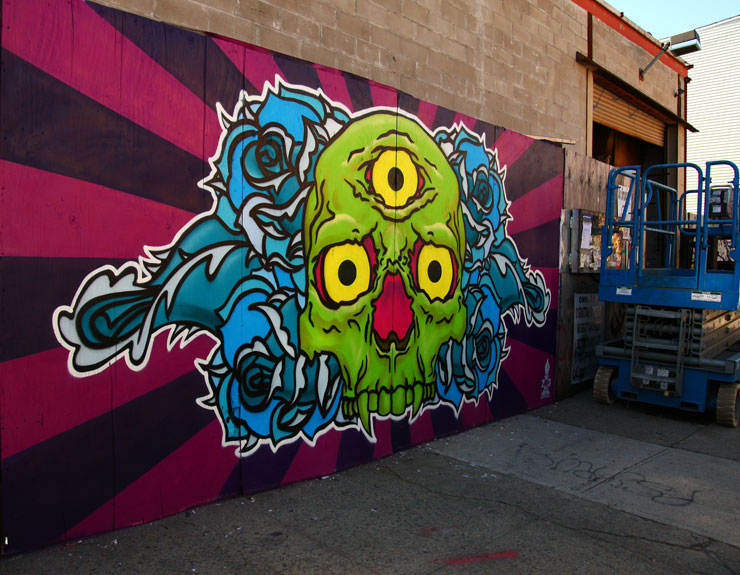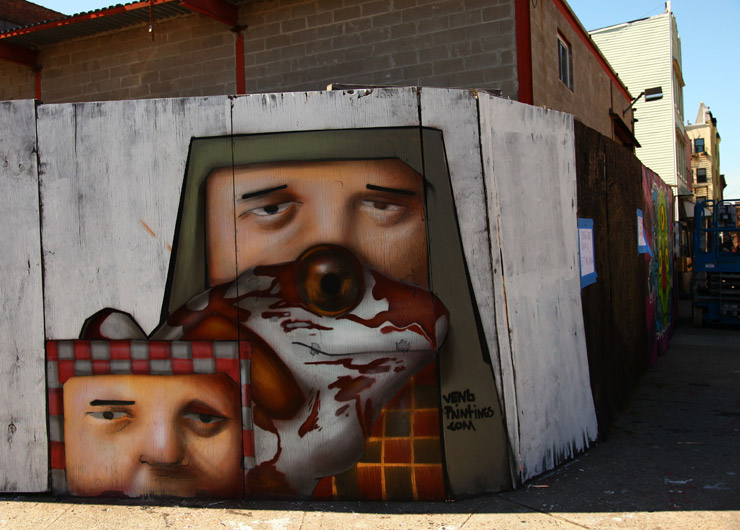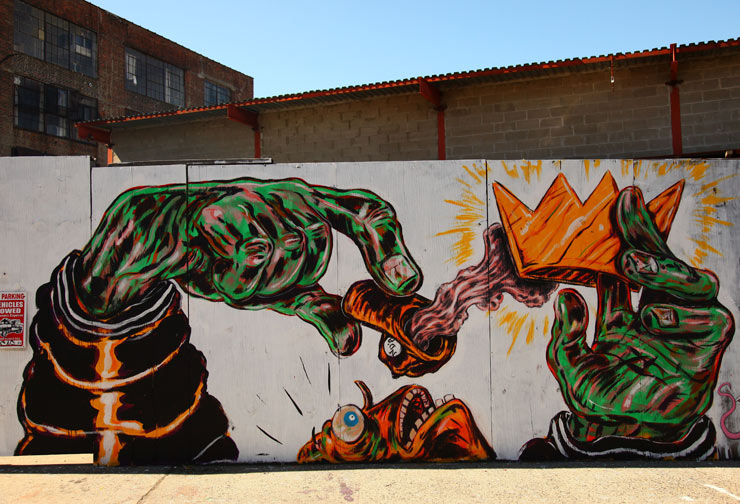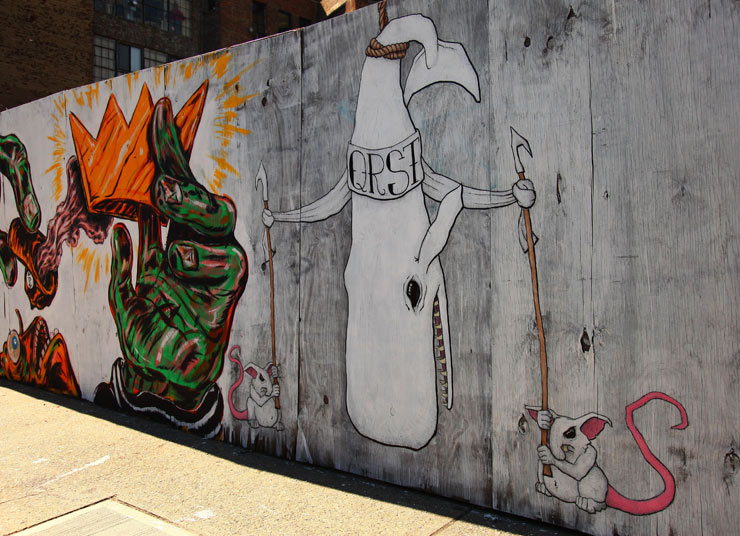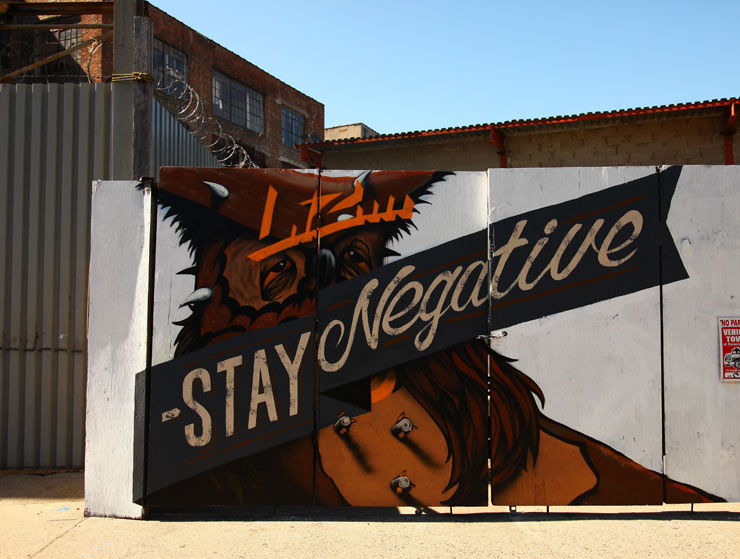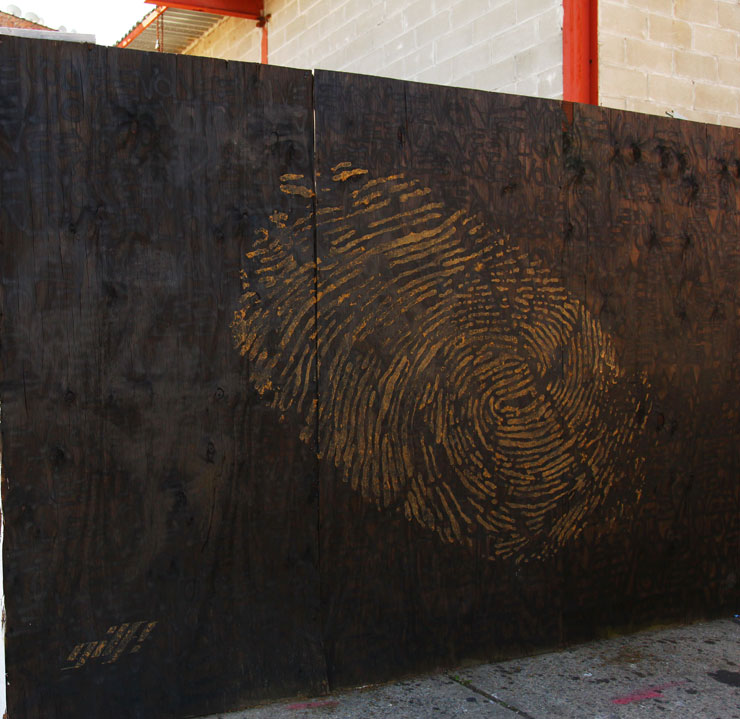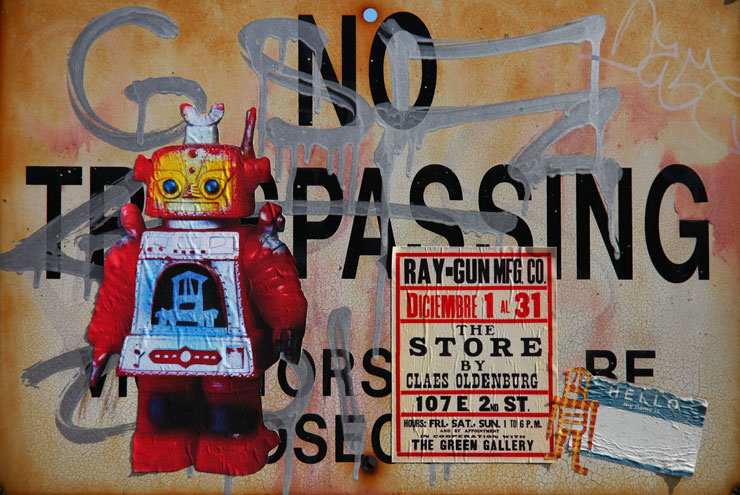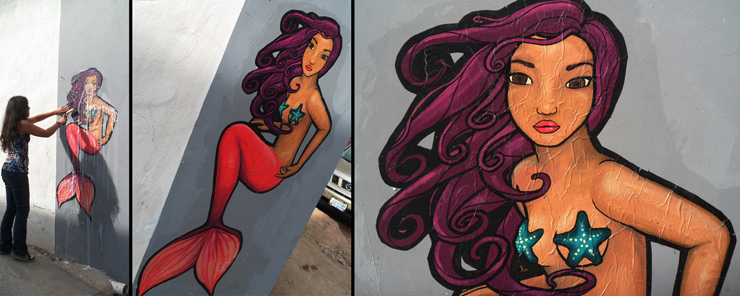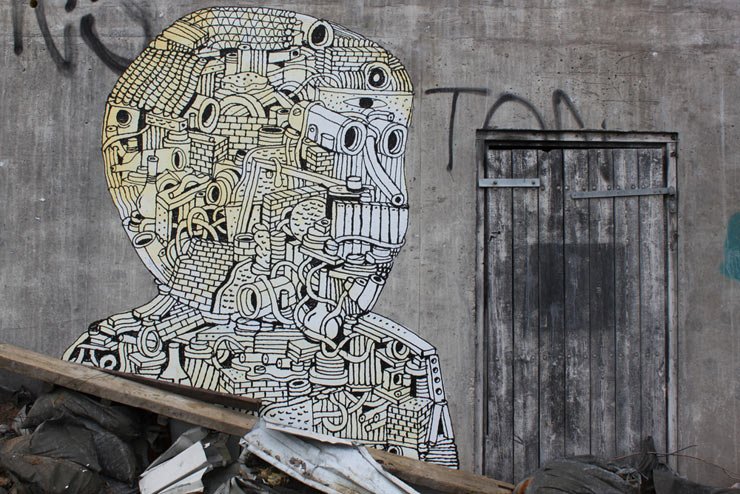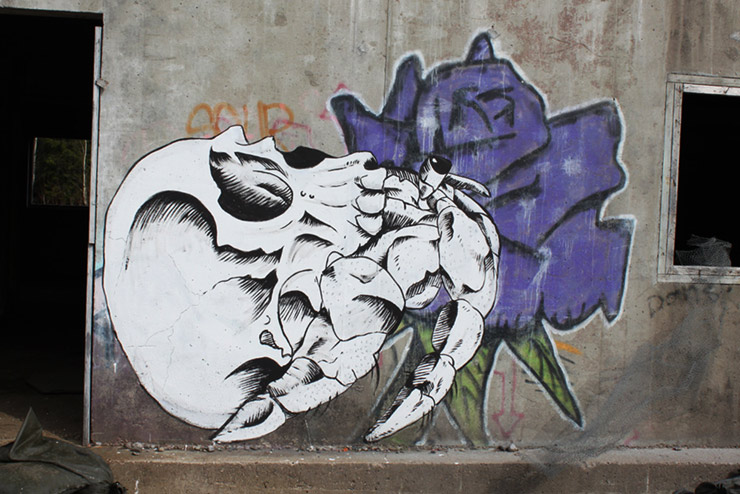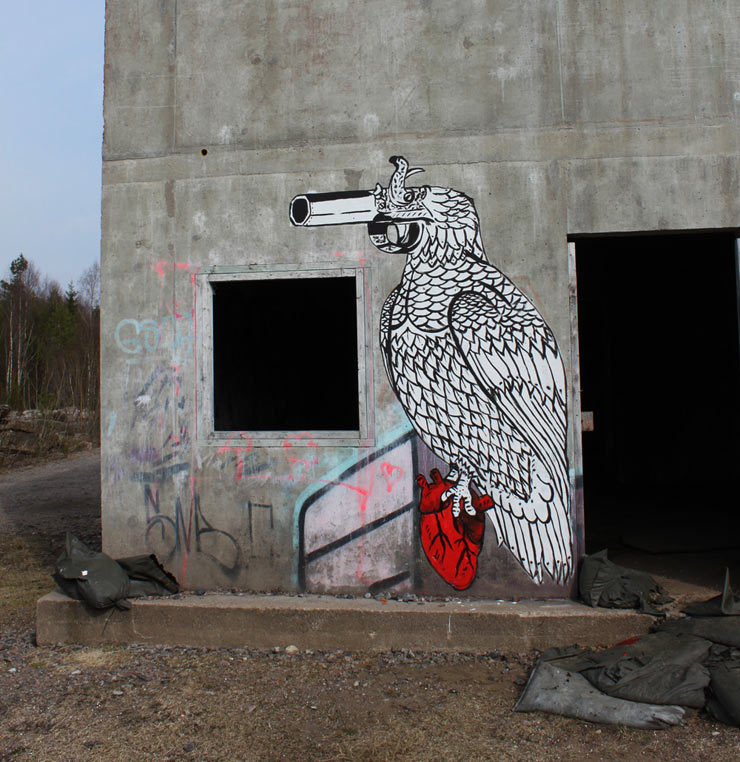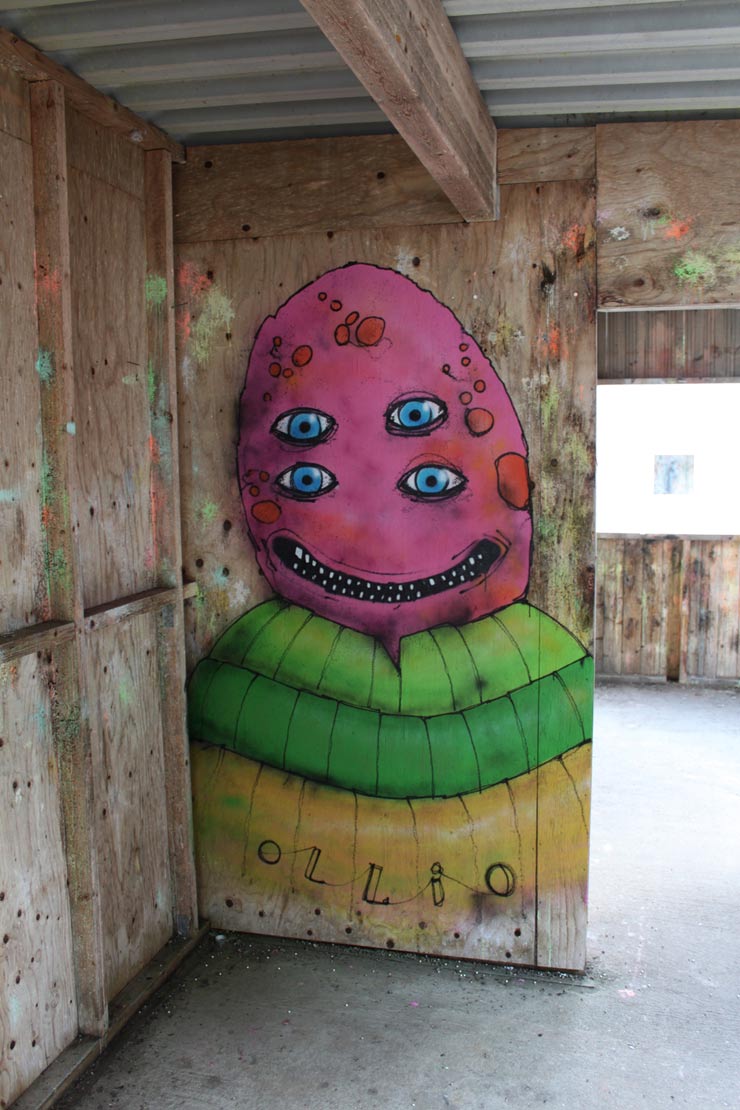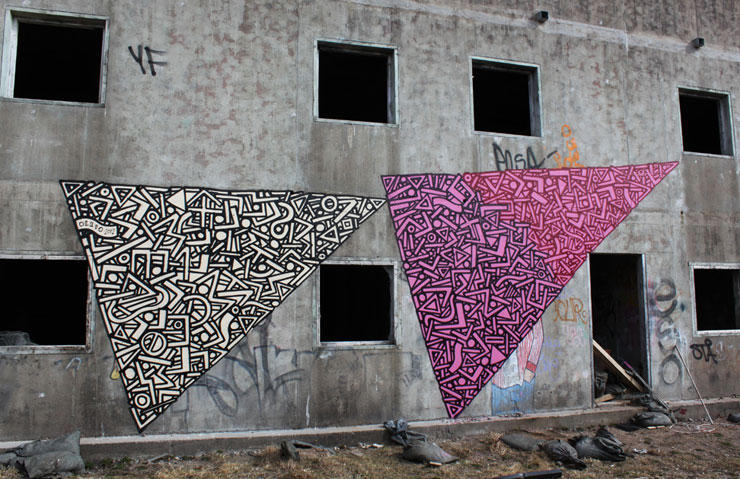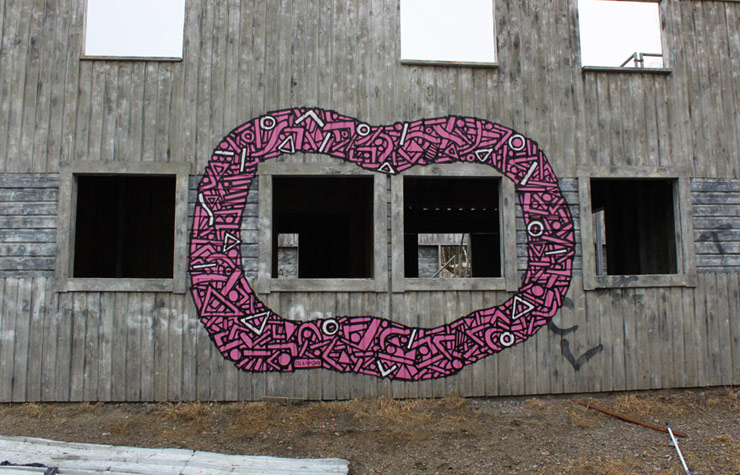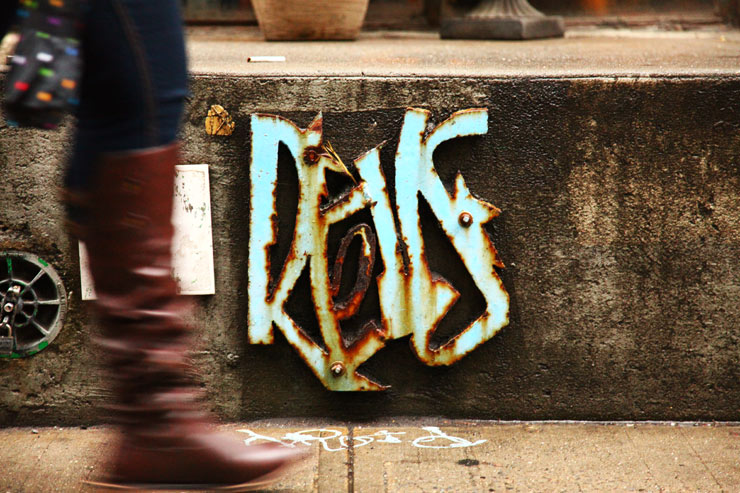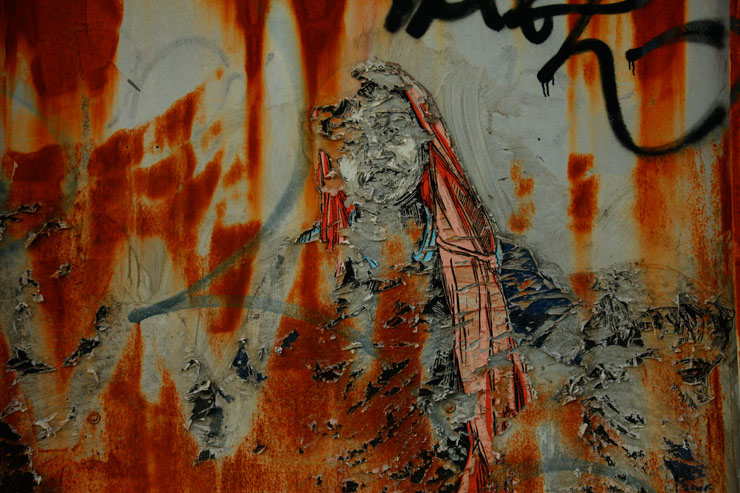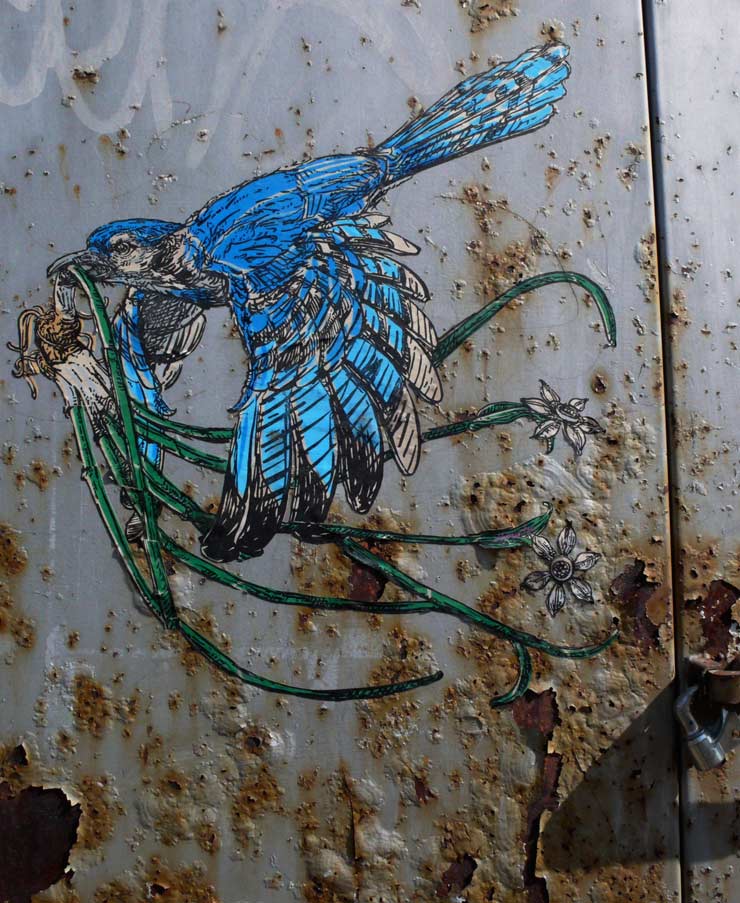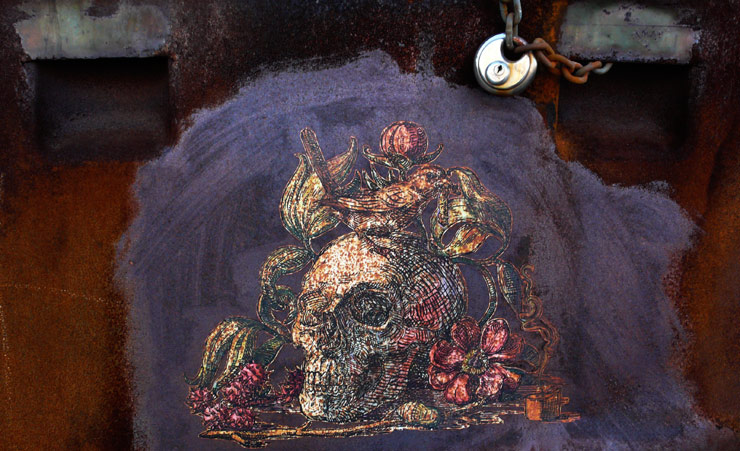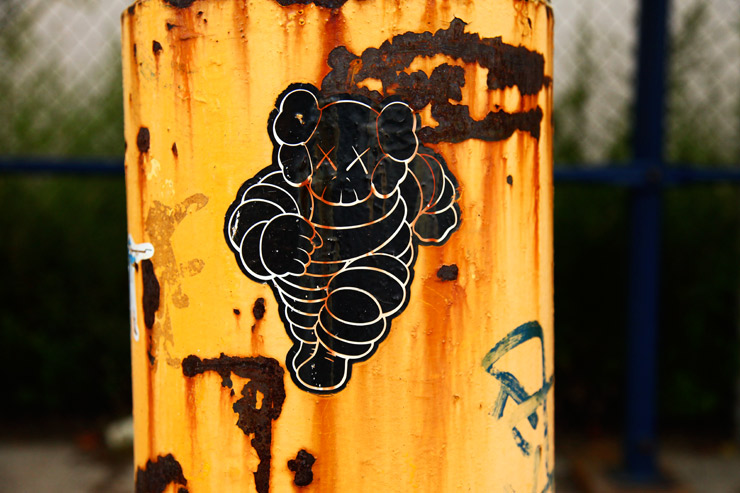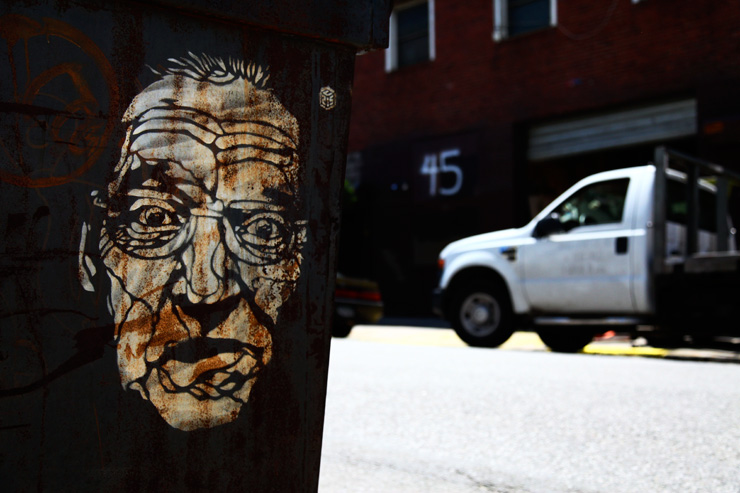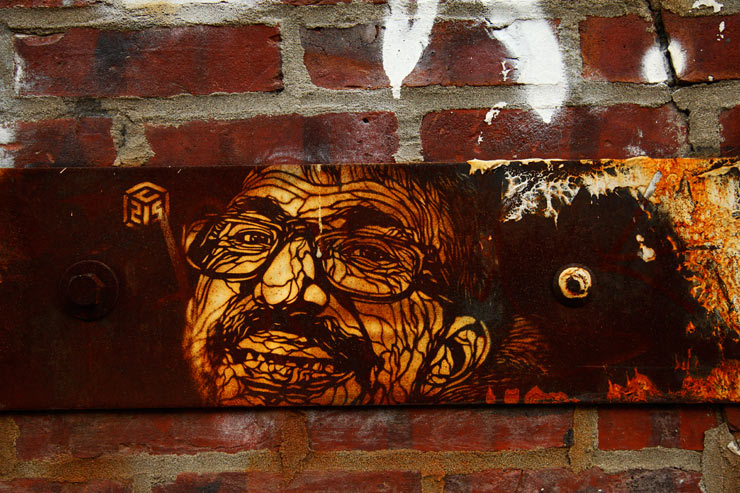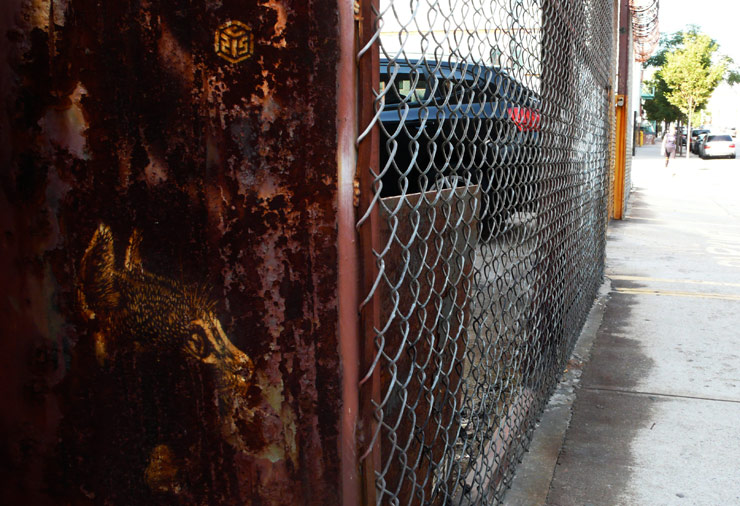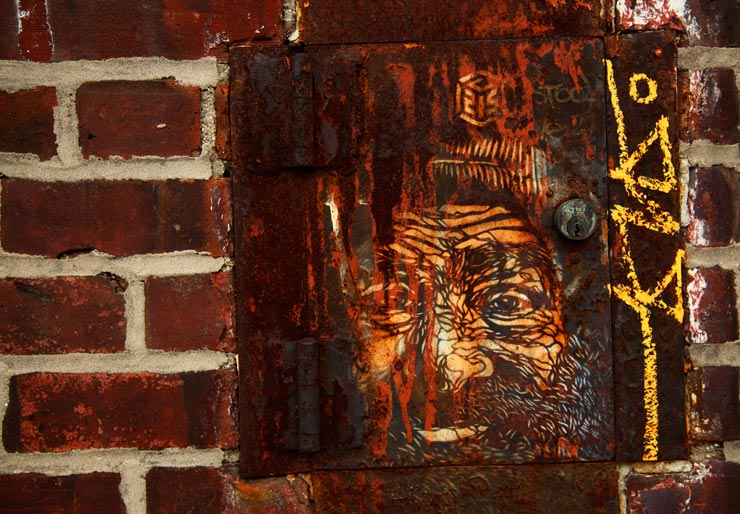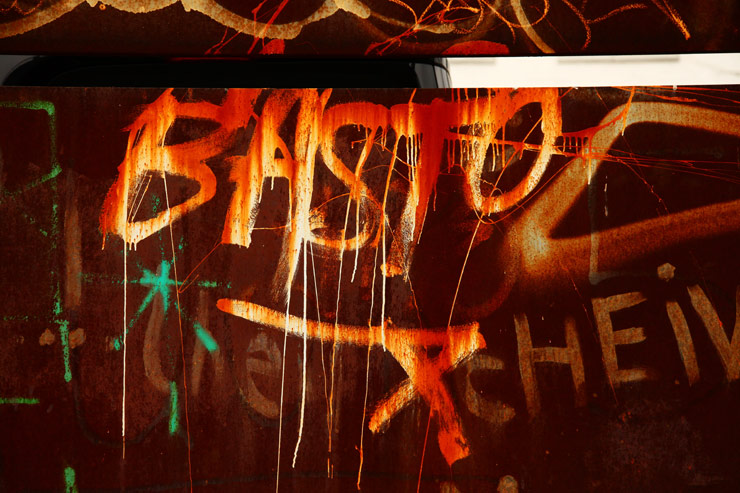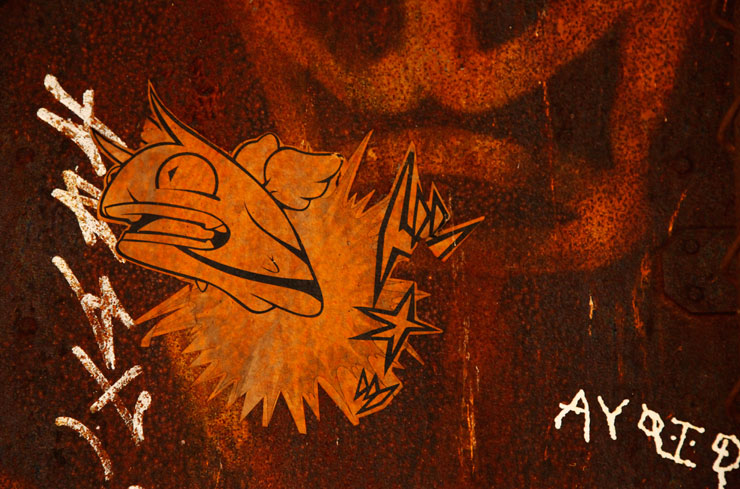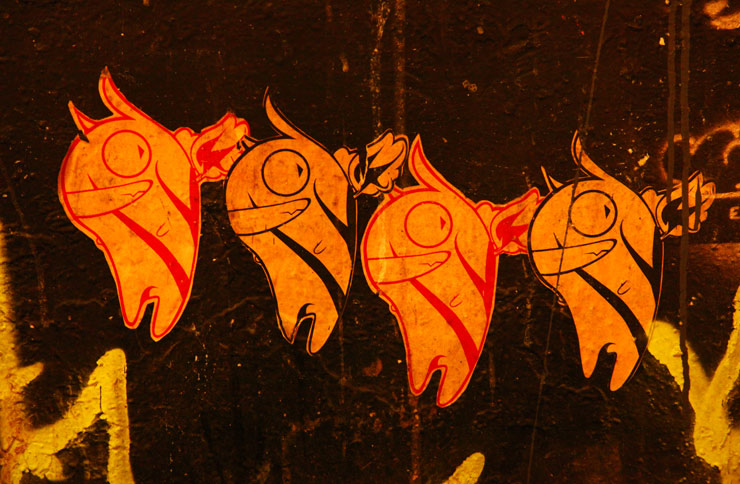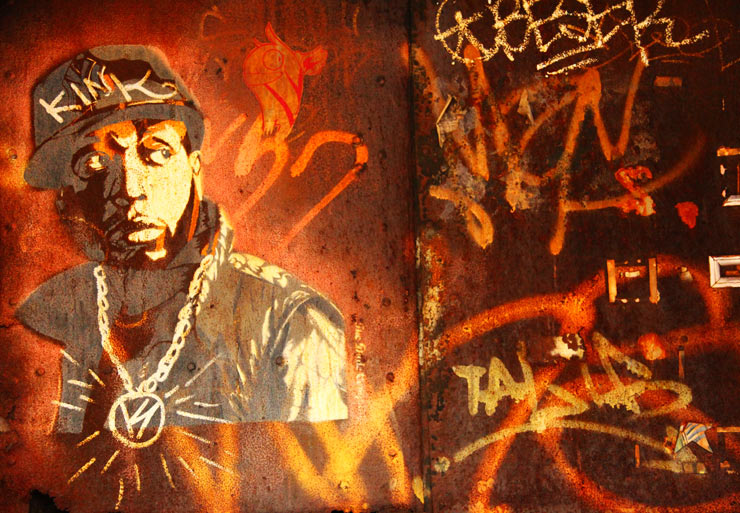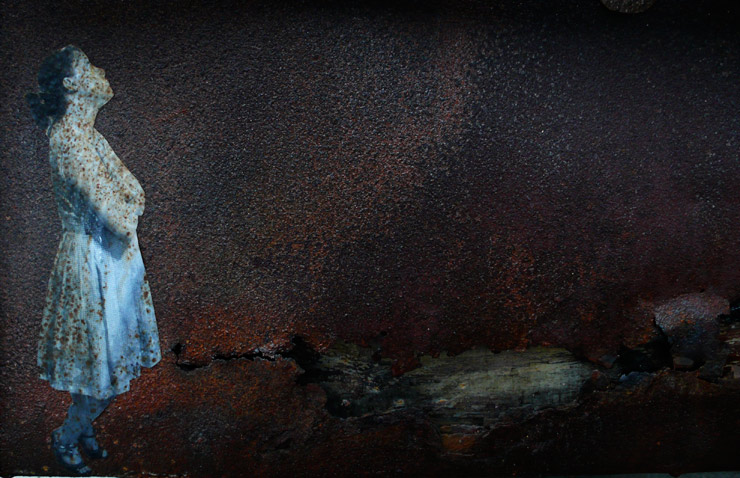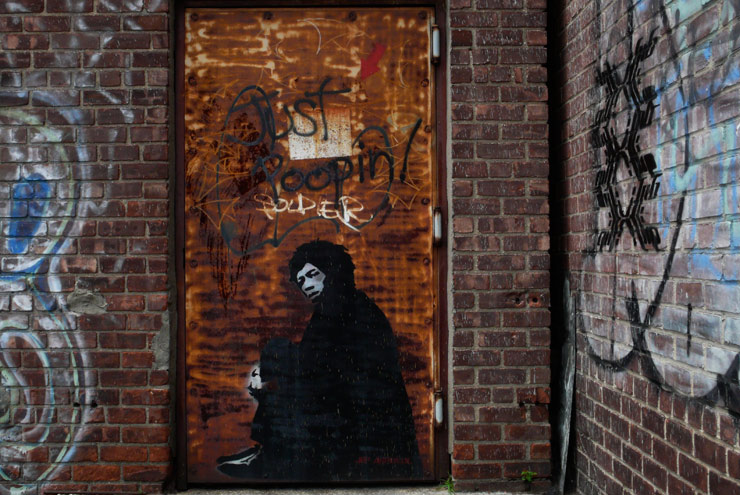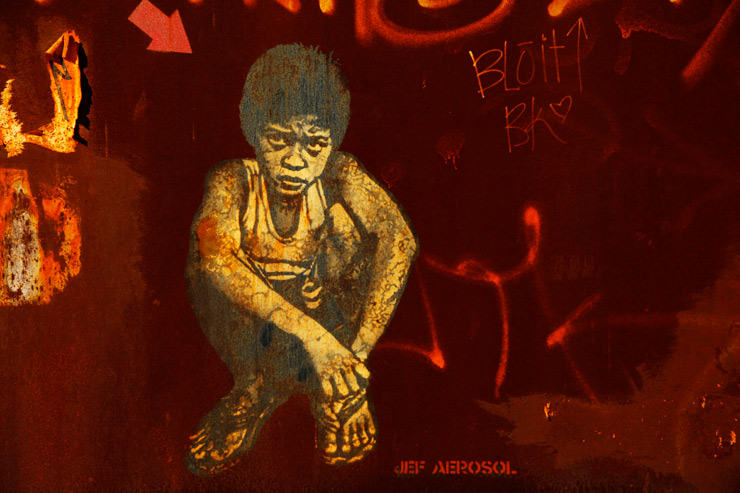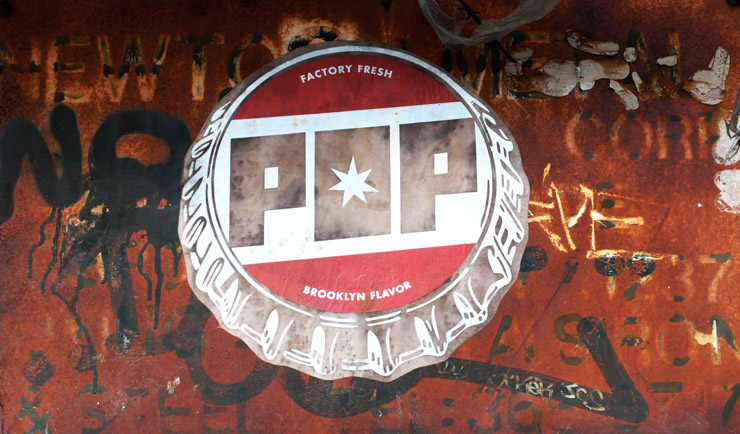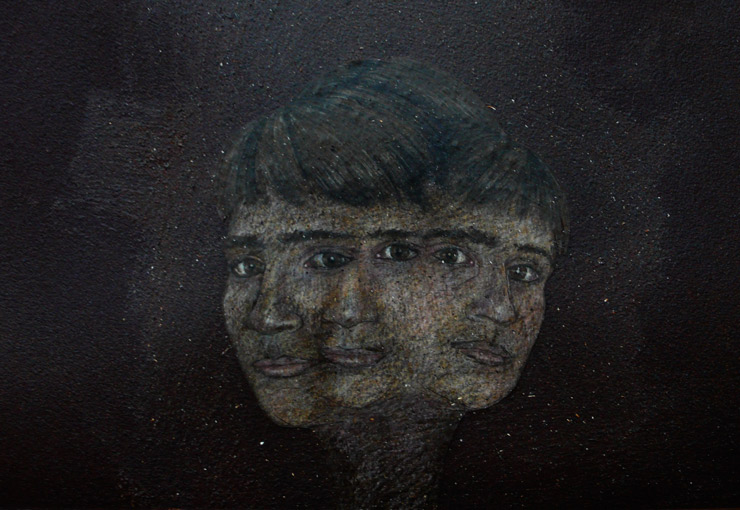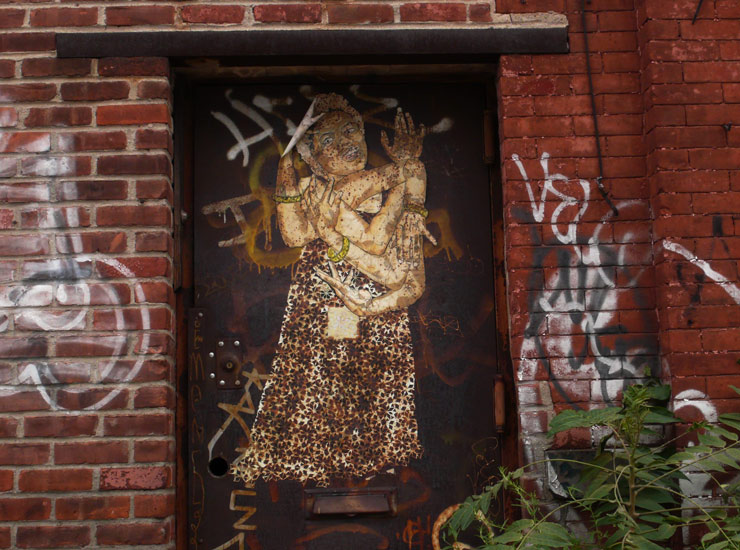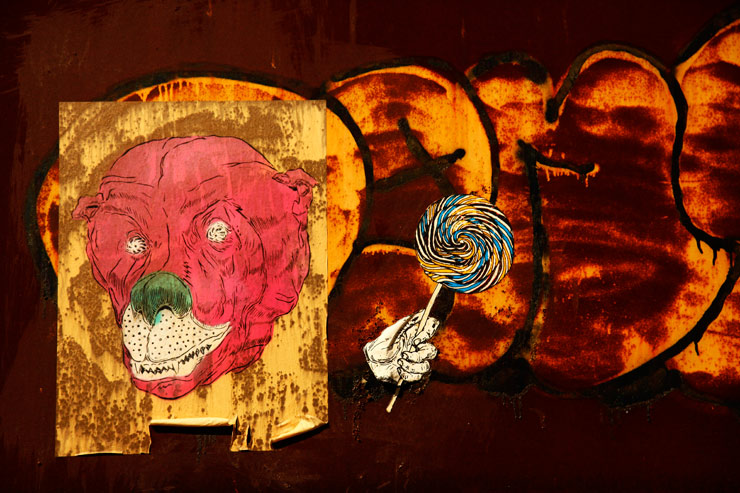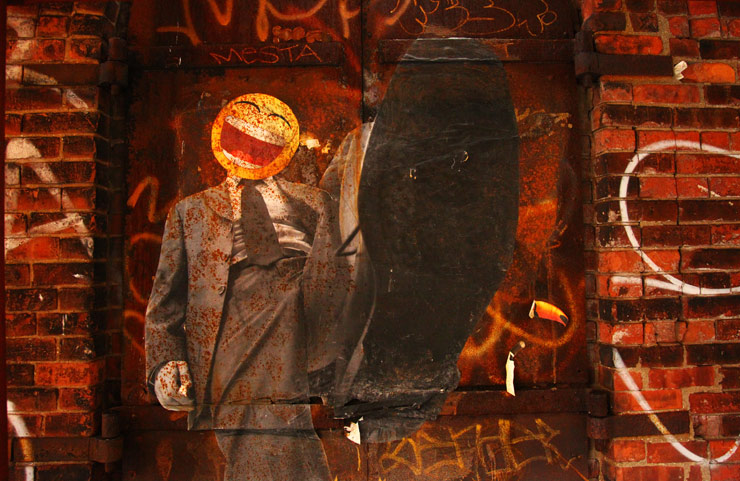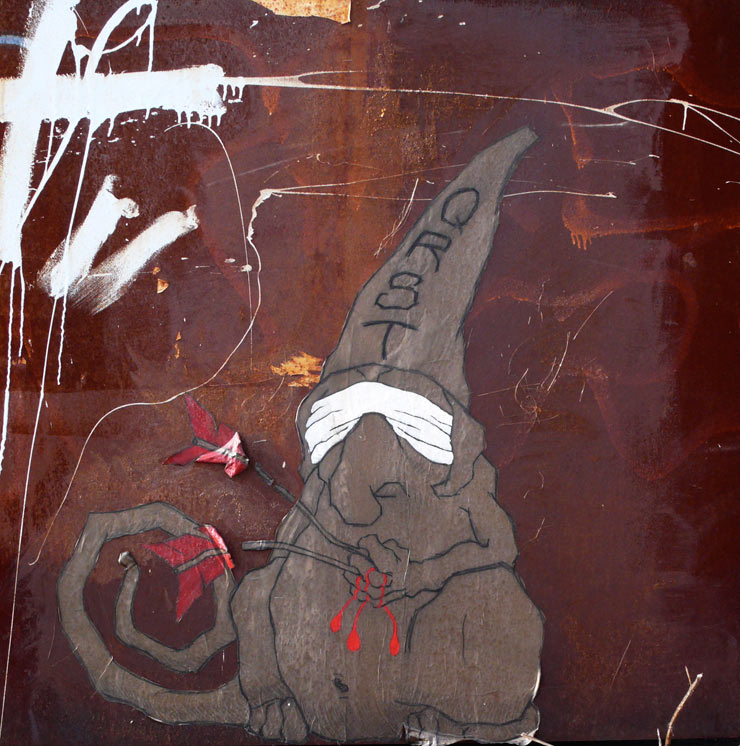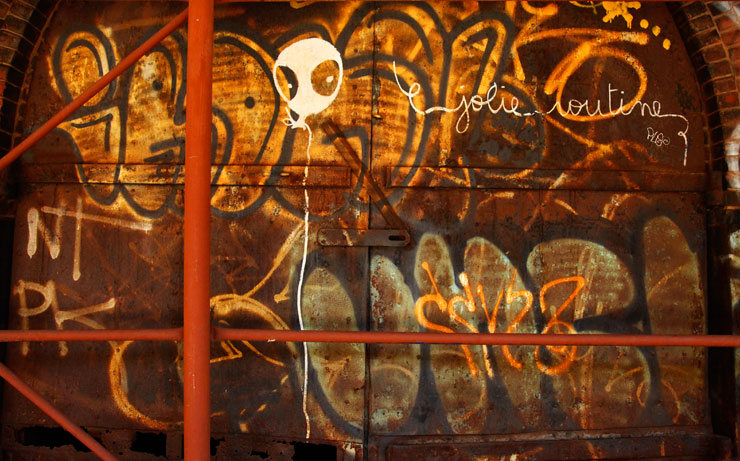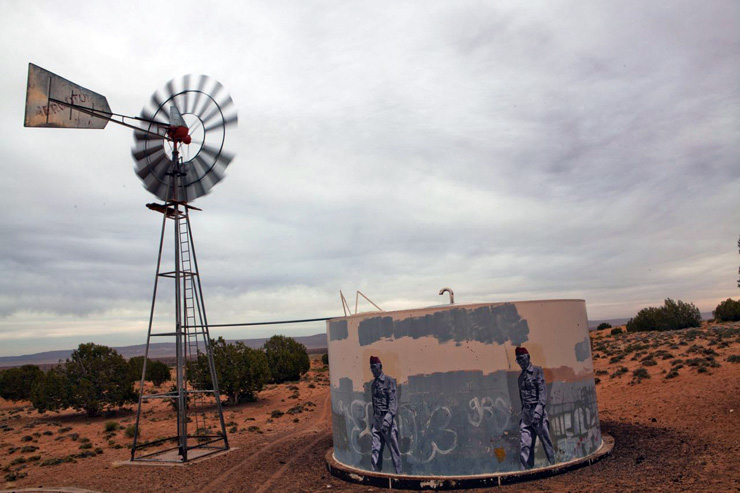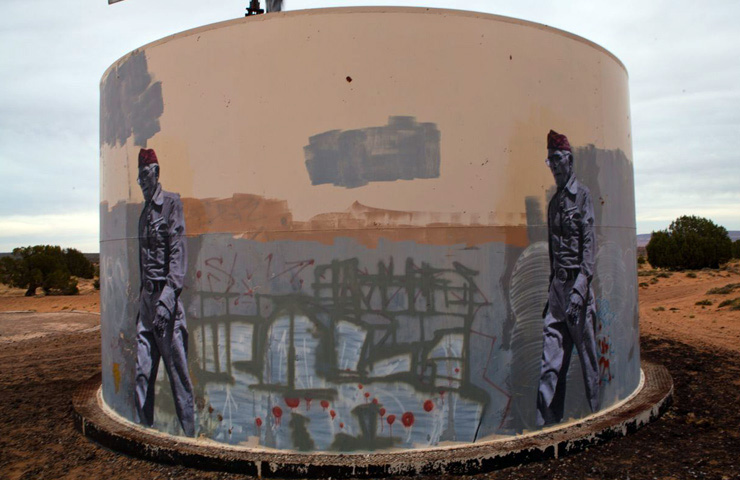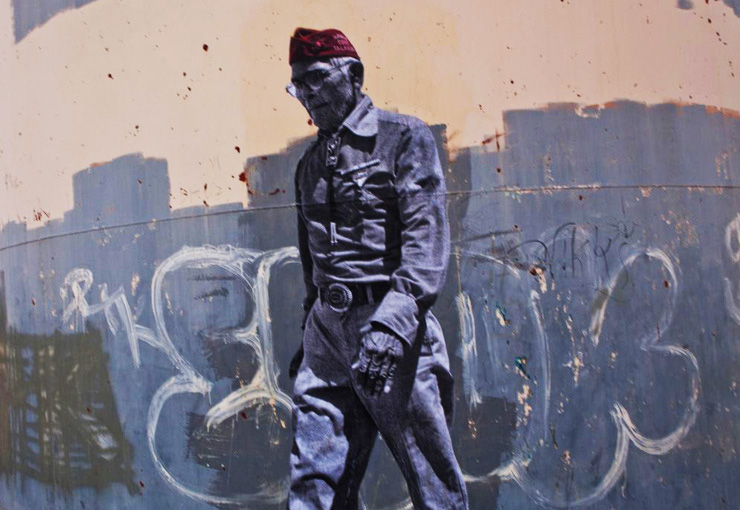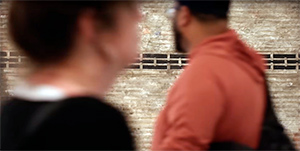On August 12, 2010, Lek and Sowat found an abandoned supermarket in the north of Paris. For a year, in the greatest of secrets, both artists continuously wandered in this 430,000 sq ft monument to paint murals and organize an illegal artistic residency, inviting forty French graffiti artists to collaborate, from the first to the last generation of the graffiti movement. Together they built a Mausoleum, a temple dedicated to their disappearing underground culture, slowly being replaced by street art and its global pop aesthetics.
On the Street
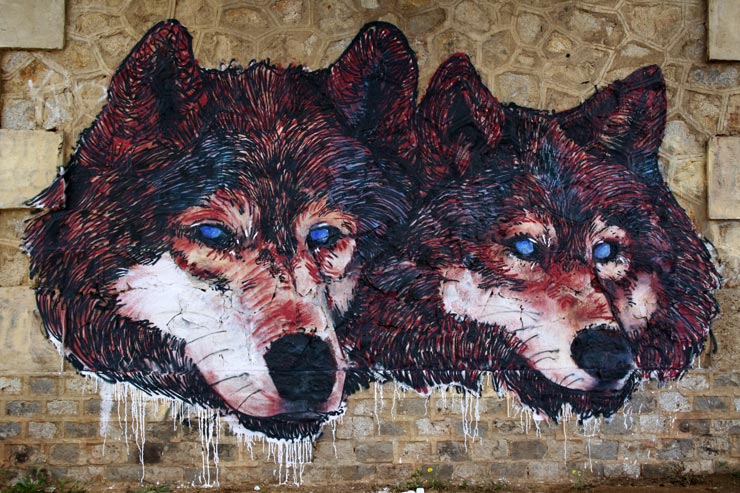
Jeice2 Brings 2 Wild Wolves in Gerena, Spain
Jeice 2 checks in the with the animal kingdom as he starts a new series he’ll call “Savage Planet”. The street artist has experimented with a variety of styles on the street over the last year including a bright abstract lined candy corner in Seville and most recently a portrait of William Burroughs.
Jeice 2 “The Couple” (photo © Jeice2)
Here he brings “The Couple” to a supporting bridge pylon – with a natural hand and sketch stroke, the topic and the style may remind you of animal portraiture done by Gaia, Yote, ROA, and more recently Willow in New York. Here in a greener environment that’s more natural than the urban detritus of Brooklyn, it feels more home-like for these two blue eyed beauties.
Jeice 2 “The Couple” (photo © Jeice2)
Jeice 2 “The Couple” (photo © Jeice2)
Jeice 2 “The Couple” (photo © Jeice2)
Images of the Week: 04.08.12
Our weekly interview with the street, this week featuring Anarkia, Gaia, Sien, Stem, Tats Cru, Woebots, Velma from Scooby Doo and XAM.
Anarkia (photo @ Jaime Rojo)
Gaia (photo @ Jaime Rojo)
This version of Velma looks a little sexified. Mysterious. Artist Unknown (photo @ Jaime Rojo)
Tats Cru (photo @ Jaime Rojo)
Who’s your Daddy? Here is a brand new DNA testing truck coming soon to a corner near you. Tats Cru redefines the use of the taco truck in this work in progress for a commercial company…stay tuned. (photo @ Jaime Rojo)
How’s this for a tag? XAM. (photo @ Jaime Rojo)
The new right wing Republican slogan? Artist Unknown (photo @ Jaime Rojo)
Woebots (photo @ Jaime Rojo)
Sien and Stem (photo @ Jaime Rojo)
Artist Unknown (photo @ Jaime Rojo)
Artist Unknown (photo @ Jaime Rojo)
Untitled (photo @ Jaime Rojo)
G40 Art Summit in Richmond: The Art of the Mural
Arts festivals have a proud tradition of bringing creative expression directly to people on the street. When you talk about graffiti and Street Art you normally focus on the singular Street Artist who deigns their location and manner of display in the urban environment. But sometimes the display is collective and the planning and execution is actually a curatorial exercise with community arts leaders.
The ancient Greeks had the “Great Dionysia” spring art festival in April in Athens with tragedies of Æschylus, Sophocles, and Euripides. Queen Victoria famously opened the Great Exhibition in 1851 that might have launched hundreds of cultural fairs world wide since. Chicago has had the 57th Street Art Fair since 1948 that showcases original work and benefits the artists directly.
At any given moment there is a non-profit, public, or private cultural institution planning some sort of foray into the public sphere with the arts – sometimes with the full or tacit agreement of the community and often with it’s ignorance.
Street Artist JAZ getting up in Richmond, Virginia in this still from a video for the G40 summit (below).
And of course Street Art festivals have been running hard around the world in the last decade including Fame in Italy, Nuart in Norway, Cans in London, the stencil festival in Melbourne … the list continues to grow. Recently in the US we’ve been seeing Living Walls pop up in Atlanta and Albany, Open Walls in Baltimore and today we’re looking at the town of Richmond, Virginia, which is currently being installed with new work by Street Artists from around the world for the G40.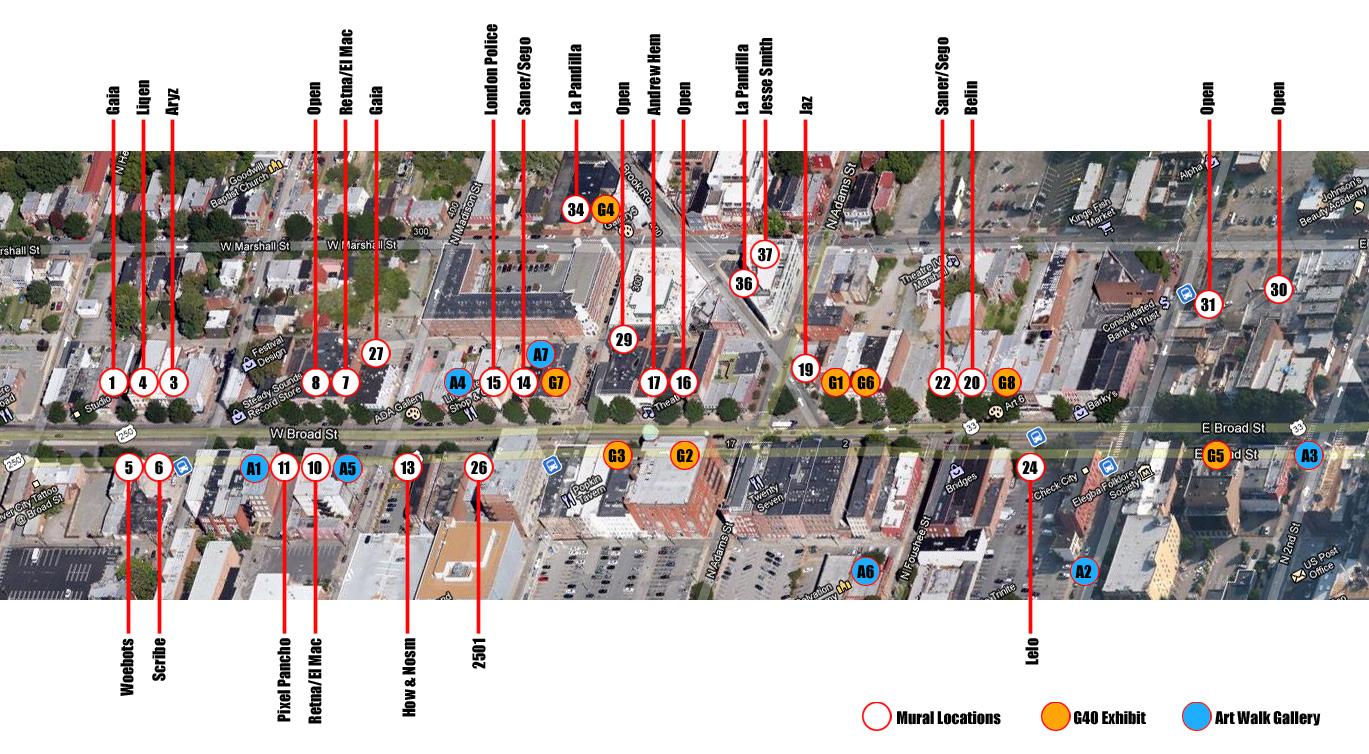
(Click image to enlarge map, courtesy Richmond.com)
The G40 Art Summit is marking its third edition and they will offer exposure to new faces in the Street Art scene and others to an audience who may never have heard of any of them, and that’s the point. For this year’s edition their focus is on “The Art of the Mural”. Art Whino, the creators and organizers have invited a handful of international Street Artists to participate.
Besides giving exposure to the artists, Art Whino explains in their press release how they hope to help the city:
“By inviting 12 of the top mural artists from around the globe to unleash their creativity to 20 large scale walls throughout Richmond, this project is sure to put the city on the map as a street art destination”.
As local art writer Christina Newton explains on Richmond.com the importance of programs like this in the public sphere ultimately goes to the average person on the street, “As many opportunities to experience art as there are in a city the size of Richmond, some will unfortunately never venture into a gallery because they think they don’t know enough about art or are shy about venturing into a space they have never been. Public art is important because it can more easily reach a broad audience, not to mention have the ability to move people out of their comfort zone, open our eyes and minds to something new, and beautify our environment.”
Artists included in the G40 this year are:
Jacopo Ceccarelli aka 2501, Italy, Angry Woebots – California, Aryz – Spain, El Mac – California, Gaia – New York, , Jaz – Argentina, Jesse Smith – Virginia, La Pandilla – Puerto Rico, Lelo – Brazil, London Police – UK, Pixel Pancho – Italy, Roa – Belgian and Scribe – Kansas City.
Here some examples of work on the street by some of the artist captured by Jaime Rojo.
El Mac (photo © Jaime Rojo)
Gaia (photo © Jaime Rojo)
Jaz (photo @ Jaime Rojo)
La Pandilla (photo @ Jaime Rojo)
The London Police (photo @ Jaime Rojo)
Pixel Pancho (photo @ Jaime Rojo)
ROA (photo @ Jaime Rojo)
For further information regarding the G40 Summit click here.
For further information regarding Art Whino Gallery click here.
From Here To Fame Publishing Present: Arabic Graffiti & Egyptian Street Art in Frankfurt. (Frankfurt, Germany)
Arabic Graffiti & Egyptian Street Art in Frankfurt
![]()
Graffiti artists from Egypt, Tunisia and Germany will create a street art gallery from 10th of April around the Tutankhamun exhibition hall in Frankfurt. Some of the best known and most active street artists from Egypt will participate, including Aya Tarek, Ammar Abo Bakr and Ganzeer. El Seed, a street artist from Tunisia whose work has influenced graffiti artists around the Arab world, and Andreas von Chrzanowski aka Case from Germany, who recently did murals in Egypt, complete this distinguished line-up.
Friday 13th of April
![]()
Opening of the Street Art Gallery
First Friday Egyptian Street Art & Arabic Graffiti
7:00 pm – Midnight
Arabic Graffiti – El Seed & Don Karl present the book and project
8:00 pm – Exhibition Foyer
Street Art of the Egyptian Revolution – Ganzeer & Don Karl
9:00 pm – Exhibition Foyer
Tutankhamun exhibition hall, Mainzer Landstraße, Güterplatz, 60327 Frankfurt am Main
Since the start of the Arab uprisings the Middle East has seen an unparalleled explosion of graffiti. Many slogans which were later sung by the people on the streets first appeared on walls from Tunisia to Bahrain. Egypt has played a remarkable role in this phenomenon. Even when the army tanks rolled onto Tahrir Square in Cairo, they were immediately adorned with graffiti. Along with people from all walks of life, artists, calligraphers and designers took over the public space. In no time a vital and now globally acclaimed street art scene emerged. Arabic Graffiti is an intercultural project by From Here To Fame that involves artists, activists and academics from various Middle Eastern countries and their diasporas. Started as an art and book project, the recent events in the region have led to an active involvement of many participants in the transforming changes of the region. Events and exhibitions are currently being developed in Tunisia, Egypt, Lebanon, France and Germany.
The project Arabic Graffiti & Egyptian Street Art is part of the Festival of Egyptian Culture, the program for the exhibition Tutankhamun – His tomb and treasures in Frankfurt.
Chris Jordan : A Bold Light Artist Hits Iconic Icelandic Church
Rafmögnuð Náttúra: The Hallgrimskirkja Church in Reykjavik, Iceland
It’s not that light artist Chris Jordan didn’t find the sweeping supersonic jet-shaped façade of the church inspiring. He just wanted to make it visible again to the people in town.
Hallgrímskirkja, the Lutheran church in the center of Reykjavík, with it’s soaring steeple and outstretched wings it has been an architectural icon since it’s completion in 1986 and anyone first laying eyes on the largest Icelandic church is usually impressed by it’s command and design. And yet, somehow even pivotal architecture can disappear before our eyes due to familiarity and it may take a visionary talent like Jordan to bring it back to our attention with animation, mapping, color, and pattern.
Marcos Zotes and Chris Jordan “Rafmögnuð Náttúra” (photo © Enki)
From his home in New Yorks’ Chinatown, Jordan, who teaches interactive design at Baruch College and New York University, talks about his work in the same way that Street Art is often credited in the urban environment: art as activation. “Activating is about changing people’s perceptions of overlooked or invisible spaces. A building can become an archetype, invisible, like for a New Yorker, for example, the Statue of Liberty. You look at it, and it disappears into the thousands of times you’ve already seen it. So for me, this light project was so exciting because here’s this massive landmark church that this whole town can’t see anymore.. made completely fresh and new. To see that reflected back at me through the faces of viewers was exhilarating.”
Marcos Zotes and Chris Jordan “Rafmögnuð Náttúra” (photo © Enki)
That observation perhaps was the pinnacle of his Icelandic experience in February when he camped out in front of the church over four days in the back of a box truck with his collaborator Marcos Zotes, a handful of computers, three projectors, and a low budget. Together they created a series of site-specific video performances that brought to life Zotes’ idea for a project called Rafmögnuð Náttúra.
The two had met while Jordan was performing his 24 hour timelapse of Hurricane Irene inside an engineered cloud at New York’s Bring to Light Festival last October. Zotes asked if Jordan would like to collaborate on a project to illuminate the 150 foot wide façade of a church in for the Winter Lights Festival in Iceland. Since Jordan has over the last decade created installations appearing at MoMA, The New Museum, The Whitney, The Museum of Natural History, The Chelsea Museum, in Times Square, and many unusual places in between, he had a good idea what cool stuff he would like to do. With the free help of other artists, software designers, and even NASA, Jordan brought a mind-blowing façade to the church that Zotes had only imagined.
Marcos Zotes and Chris Jordan “Rafmögnuð Náttúra” (photo © Enki)
“We collaborated on how we could, with a very limited budget, create something spectacular for the festival,” explains Jordan. “We knew that the majority of the budget would be going for projectors so we called our friends up to help us with creating animation sequences that could be mapped to the facade, in triple-HD resolution.”
“We developed a workflow and a template for each animator to follow; then compiled the animations together into a final 15-minute composition. In addition, I contacted friends at NASA for solar imaging data, and created animations using graphic and solar elements. The dream was to have northern lights over the building with the accompanying solar data displayed. Although the solar and earth weather didn’t collaborate, the animations of the sun in a dark cold city on this Norse façade were very appropriate and powerful.”
Marcos Zotes and Chris Jordan “Rafmögnuð Náttúra” (photo © Enki)
Jordan’s work over the years has included explorations into memory, and elements of photography, film, interactivity, and projections. We talked with Jordan about traveling to Iceland, transparent ideas, the importance of community, and what a light artist has to go through to reactivate an icon.
Brooklyn Street Art: Can you talk about the trip to Iceland?
Chris Jordan: We went to Iceland with just one day before the opening. The Icelandic people were incredibly accommodating, and set up three massive projectors inside a box truck, with a massive piece of glass mounted on it. The box truck became our projector-heated cabin in the center of Reykjavik for four days. Location is everything! It was a great setup. The projectors were aligned and from there I mapped the content using the software MadMapper by Garage Cube. Garage Cube are also friends of mine and they helped me troubleshoot the tech issues the day before. The opening event had the band For a Minor Reflection accompany us, right after the mayor of Reykjavik introduced the festival to the audience.
But the day before this we went through myriad technical issues. Many times I thought this was going to either look horrible, or crash altogether. There was no budget for a backup computer, or to test the entire setup beforehand. Luckily, Iceland has an early sunset, so we gleaned a couple crucial extra hours to configure everything. The mapping was completed literally seconds before the mayor spoke. It all went off smoothly and the people that braved the intense horizontal-downpour cheered.
Marcos Zotes and Chris Jordan “Rafmögnuð Náttúra” (photo © Enki)
Brooklyn Street Art: You managed to transform a landmark into a completely different light using your creativity. Doesn’t that feel pretty powerful?
Chris Jordan: Yes. It was pretty fantastic we were able to do this on such a small budget. It absolutely required a community to make happen. When our main computer failed, the Icelandic underground came to the rescue. One person there offered graphics cards he’d had in a drawer. Another brought us snacks from a nearby cafe. That community effort is really what made this project powerful for me.
Marcos Zotes and Chris Jordan “Rafmögnuð Náttúra” (photo © Enki)
Brooklyn Street Art: You were given no budget whatsoever, aside from a plane ticket and 3 projectors. How do you plan for a live performance with the inevitable technical issues?
Chris Jordan: Years and years of failure. I read an Edison quote the other day, “If you want to succeed, double your failure rate”. I’m also a huge proponent of transparency, modularity, and scale. These tenets allow me to see unique solutions to problems, and find compelling solutions. Light art is still maturing as a public medium, as last November’s Occupy Wall Street “Bat-signal” projections attest. It’s a wide-open field for creative expression.
Marcos Zotes and Chris Jordan “Rafmögnuð Náttúra” (photo © Enki)
Brooklyn Street Art: Without revealing your trade secrets, is it true you plan to introduce more community interaction into your future work?
Chris Jordan: Always. There’s an axiom I live by: “There is no art without politics”. You either choose to engage it, or you choose political apathy. This ties in with ideas around real-time performance and feedback. I hate the word “rendering”, as it equates to “pouring concrete” on ideas that demand continuing dialog. “Trade secrets” imply hoarding of knowledge. I only want to work with transparent ideas and accessible technologies that ‘spotlight’ the individual’s role in society through creativity. I try to live an open-source life.
Brooklyn Street Art: What role does community play in this project and in your philosophy?
Chris Jordan: I love interacting with communities and to give them the control to create dialogue. This fascinates me, and informs my work constantly. My next long-term outdoor installation is on Governor’s Island, where I’ll be engaging the broadest spectrum of people on the planet (New York) in playing and building, using buckets and stop motion photography. For me it’s all about the community. Without it, we are making monoliths to our egos.
Marcos Zotes and Chris Jordan “Rafmögnuð Náttúra” (photo © Enki)
Marcos Zotes and Chris Jordan “Rafmögnuð Náttúra” (photo © Enki)
Marcos Zotes and Chris Jordan “Rafmögnuð Náttúra” (photo © Enki)
Marcos Zotes and Chris Jordan on the back of their box truck. (photo © Enki)
Marcos Zotes and Chris Jordan “Rafmögnuð Náttúra” – Chris at work on his live creations. (photo © Enki)
Marcos Zotes and Chris Jordan “Rafmögnuð Náttúra”. Mission control trailer. (photo © Enki)
Marcos Zotes and Chris Jordan “Rafmögnuð Náttúra” (photo © Enki)
Marcos Zotes and Chris Jordan “Rafmögnuð Náttúra” (photo © Enki)
Marcos Zotes and Chris Jordan “Rafmögnuð Náttúra” (photo © Enki)
BSA>>><><>><><>>>BSA>>><><>><><>>>BSA>>><><>><><>>>
With very special thanks to Enki for sharing this incredible photographic story.
Rafmögnuð Náttúra, a concept by Marcos Zotes created by Marcos Zotes and Chris Jordan
Performer Coco Karol
Videographers Azmi Mert Erdem and Raghul Sridharan
Photographer Enki
and the music group For a Minor Reflection
Spring is in the Air and on the Wall: Cyrcle in Los Angeles
Ahhh, spring. Birdies, jellybeans, the smell of tulips, lavender hyacinth, aerosol paint. Cyrcle is putting up a new royally purple piece to celebrate the change of the season at LA Freewalls and Carlos Gonzalez was there to catch it in bloom.
See what Winter looked like here.
Cyrcle “Spring” for LA Freewalls Project (photo © Carlos Gonzalez)
Cyrcle “Spring” for LA Freewalls Project (photo © Carlos Gonzalez)
Cyrcle “Spring” for LA Freewalls Project (photo © Carlos Gonzalez)
Cyrcle “Spring” for LA Freewalls Project (photo © Carlos Gonzalez)
Cyrcle “Spring” for LA Freewalls Project (photo © Carlos Gonzalez)
Cyrcle “Spring” for LA Freewalls Project (photo © Carlos Gonzalez)
Cyrcle “Spring” for LA Freewalls Project (photo © Carlos Gonzalez)
Cyrcle “Spring” for LA Freewalls Project (photo © Carlos Gonzalez)
La Pandilla and Trek Matthews in Cabbagetown for Living Walls Atlanta
Let’s start off the week with our 2nd installment of Living Walls in Atlanta for 2012, a splendid overview of Cabbagetown and the installation by three of this years participants creating new murals over a nearly two week stretch, just finished and fresh for you.
La Pandilla and Trek Matthews
Text by Alexandra Parrish
Photos by Dustin Chambers
Video by Albert Lebron
Before I engage you with an individual take of La Pandilla and Trek Matthew’s twelve-day long mural production, I must foray into a brief history lesson; Cabbagetown is a tight-knit neighborhood in Atlanta that is rich with folklore and idiosyncrasies. Adjacent to the Fulton Bag and Cotton Mills, the neighborhood began as a mill town complete with shotgun-style houses built by Jacob Elsas, the factory owner. After recruiting poor whites from the Georgia Appalachian region to work in his factory, Elsas offered free housing to compromise for insignificant wages and working conditions. Legend has it that the neighborhood assumed the moniker “Cabbagetown” after a truck-load of cabbages spilled across the neighborhood; many recount a brutal smell of cabbages that could be assumed to have followed the accident or maybe it just permeated from their kitchens.
La Pandilla (photo © Dustin Chambers)
After an extensive effort towards revitalization (some would say gentrification), Cabbagetown reigns as a treasured locality in Atlanta. Although Krog Tunnel features an ever-changing display of graffiti and street art, the CSX walls that enclose the neighborhood have remained four shades of grey. Surprisingly, when Living Walls contacted the Cabbagetown Neighborhood Association to allow La Pandilla, from Puerto Rico and Trek Matthews from Atlanta to paint two murals, they more than accommodated.
La Pandilla (photo © Dustin Chambers)
As soon as La Pandilla and Trek Matthews began on their wall, joggers, walkers and rubberneckers routinely stopped to chat and observe. Throughout production, community support yielded endless tokens of gratitude – fresh baked bread, beer runs, grilled cheese sandwiches, salvaged fresh-till packaged meals, oral histories and loud music. Even the infamous rogue buffer that verbally threatened La Pandilla (yes, Cabbagetown is home to it’s very own vigilante, occasionally violent buffer) grew to appreciate the finely detailed work that replaced decades of juvenile tags.
The truth is, Alexis Diaz and Juan Fernandez of La Pandilla are insane. Their method of using Chinese ink to translate immensely detailed drawings into full-scale murals costs a lot of time. Although they’d camp out at their wall from sunrise to sunset each day, they failed to finish on time. Hardly defeated, La Pandilla opted to stay an extra day and completed their 25-foot mural in their last hours.
La Pandilla (photo © Dustin Chambers)
Three blocks down, Trek Matthews, an emerging artist from Atlanta, began on his first public wall. His work incorporates a mash of Aztec patterns and Native American designs, which turns out nicely on the grey concrete. Despite the daunting height of his wall, Trek toughed it out on a scrappy extension ladder.
In a perfect world Living Walls would serve as proverbial residents of Cabbagetown forever. I could tell Juan felt the same way as he waved saying “bye y’all.
La Pandilla (photo © Dustin Chambers)
La Pandilla (photo © Dustin Chambers)
La Pandilla (photo © Dustin Chambers)
La Pandilla (photo © Dustin Chambers)
La Pandilla (photo © Dustin Chambers)
Trek Matthews (photo © Dustin Chambers)
Trek Matthews (photo © Dustin Chambers)
Trek Matthews (photo © Dustin Chambers)
Trek Matthews (photo © Dustin Chambers)
Trek Matthews (photo © Dustin Chambers)
Trek Matthews (photo © Dustin Chambers)
La Pandilla and Trek Matthews by Albert Lebron (VIDEO)
To learn more about Living Walls Altanta: The City Speaks and to make a donation to help this year’s conference click here. BSA thanks you for supporting this good work.
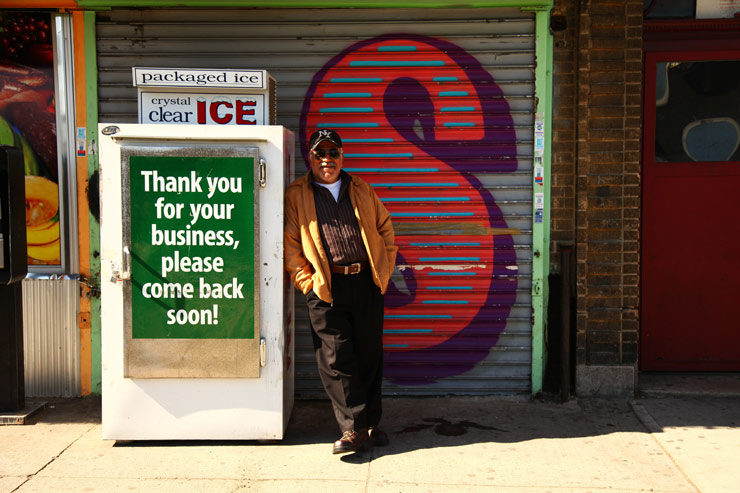
Images of the Week 04.01.12
Our weekly interview with the street, featuring Alias, B.D.White, Bast, Ben Eine, Bishop 203, Gilf, Istanbul, MEMO, ND’A, Never, QRST, RWK, Sis-Art, Stikman, Vampire Cloud, and Veng (RWK).
BAST (photo © Jaime Rojo)
BAST (photo © Jaime Rojo)
Alias. A wheat paste from Istanbul (photo © Geoff Hargadon)
Vampire Cloud (photo © Jaime Rojo)
Bishop 203 (photo © Jaime Rojo)
Veng RWK (photo © Jaime Rojo)
ND’A (photo © Jaime Rojo)
QRST (photo © Jaime Rojo)
Never (photo © Jaime Rojo)
Gilf! We’ll be keeping an eye on this one…it is going to grow! (photo © Jaime Rojo)
B.D. White (photo © Jaime Rojo)
Stikman (photo © Jaime Rojo)
Sis-Art sent this image of her wheat paste from Chapala, Jalisco, Mexico! (photo © Sis-Art)
MEMO (photo © Jaime Rojo)
Ben Eine (photo © Jaime Rojo)
Ben Eine (photo © Jaime Rojo)
Untitled (photo © Jaime Rojo)
Shai Dahan, Ollio and Ekta in the Swedish Woods
Some artists are always on the lookout for abandoned construction projects or buildings that the owners leave empty after they can’t afford to live in them, pay for the maintenance, or taxes. Developers start projects and run out of funding because their backers pull out or the economy goes into the ditch. Sometimes the developer never had the intention of finishing the job, or their backers pull out, someone gets hurt on the project, or they cannot get the necessary permits, or are in jail. The spaces feel haunted, empty, full of echo; sometimes remaining features contain remnants of stories of people you imagine lived there or worked there. Other times the empty incomplete shells contain pieces of possibilities, grand dreams for the imagined future never realized.
Ekta (photo © Shai Dahan)
Shai Dahan spent some sweet time with his Swedish homies Ekta and Ollio painting and pasting and exploring one sunny recent afternoon at a secret hidden location deep in the woods of “Smorgasland’, as Shai calls it. This abandoned spot has some nice grey industrial concrete that will add to the character of the pieces as the structure decays, molds, rusts, rots, is overgrown and overtaken by the trees and moss. Here are some new shots of the finished pieces exclusively to BSA readers.
Ekta (photo © Shai Dahan)
Shai Dahan (photo © Shai Dahan)
Shai Dahan (photo © Shai Dahan)
Ollio (photo © Ollio)
Ollio (photo © Ollio)
Ollio (photo © Ollio)
Rusted Metal: Canvas and Collaborator on the Streets
Street Art is ephemeral. That, for the most part is true. Unless we consider the role that the Internet plays in the way most people experience it. Then it doesn’t seem ephemeral at all.
From the moment a piece of Street Art appears, its evolution begins. Transformed by the elements; rain, sun, the rusting and oxidation of metal, the fading of paper. If you become familiar with a piece on the street, you might see it daily on your way to work or school or the laundromat. Over time it matures, evolves, takes on new characteristics, and eventually disappears.
Today we look at metal and it’s collaborative behavior as art material, its personality, its natural qualities. Industrial lots, garbage bins, heavy old gates secured with chains and locks, scrap yards, untreated wood facades – they all provide a myriad of surfaces, textures, shapes that serve as canvas and collaborator. Over time you observe the aging process of a stencil on a metal plate, or a decaying wheat paste peeling off of it or rusting into it, masking it’s shape onto it. The collaboration of materials and elements can be one of the most beautiful experiences one encounters on the streets, even an enduring one.
Here are some pieces on metal for you to enjoy.
Revs (photo © Jaime Rojo)
Swoon (photo © Jaime Rojo)
Elbow Toe (photo © Jaime Rojo)
Elbow Toe (photo © Jaime Rojo)
Kaws (photo © Jaime Rojo)
C215 (photo © Jaime Rojo)
C215 (photo © Jaime Rojo)
C215 (photo © Jaime Rojo)
C215 (photo © Jaime Rojo)
Bast (photo © Jaime Rojo)
See One (photo © Jaime Rojo)
See One (photo © Jaime Rojo)
The Dude Company (photo © Jaime Rojo)
Anera (photo © Jaime Rojo)
Jef Aerosol (photo © Jaime Rojo)
Jef Aerosol (photo © Jaime Rojo)
Skewville (photo © Jaime Rojo)
White Cocoa (photo © Jaime Rojo)
NohjColey (photo © Jaime Rojo)
Artist Unknown (photo © Jaime Rojo)
The 1% (photo © Jaime Rojo)
QRST (photo © Jaime Rojo)
Jolie Routine (photo © Jaime Rojo)
Guarding an Oasis in the Desert
You ever been old? Me either but if I ever get there I hope I can be slim and stately and marching around a water tank, protecting a natural resource that belongs to us and future generations. That would be good and honorable work.
Here are some pics of Jetsonorama’s new work on the reservation. Check out the windmill. Nice!
Jetsonorama “Secody’s Watertank” (photo © Jetsonorama)
Jetsonorama “Secody’s Watertank” (photo © Jetsonorama)
Jetsonorama “Secody’s Watertank” (photo © Jetsonorama)
 BROOKLYN STREET ART LOVES YOU MORE EVERY DAY
BROOKLYN STREET ART LOVES YOU MORE EVERY DAY